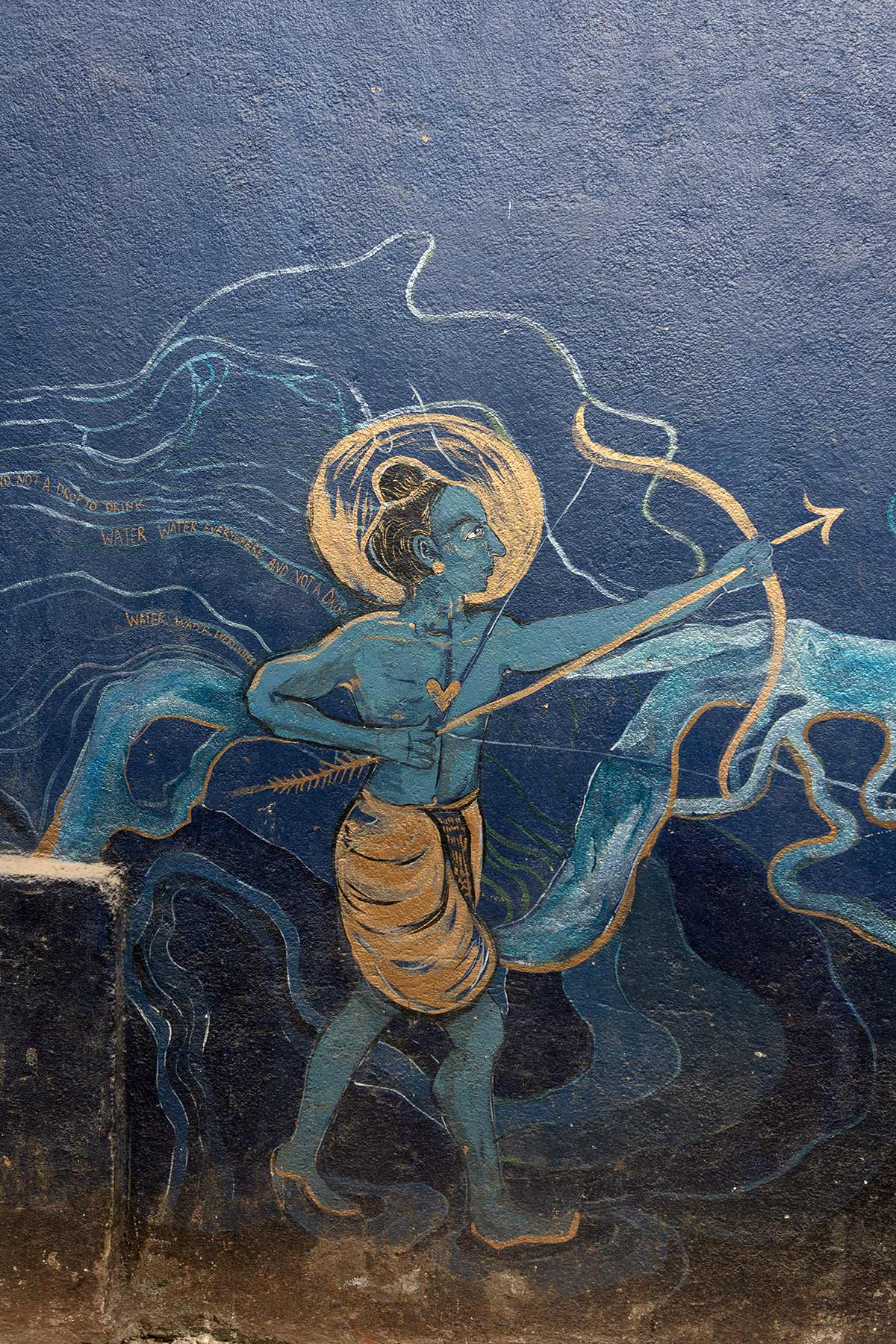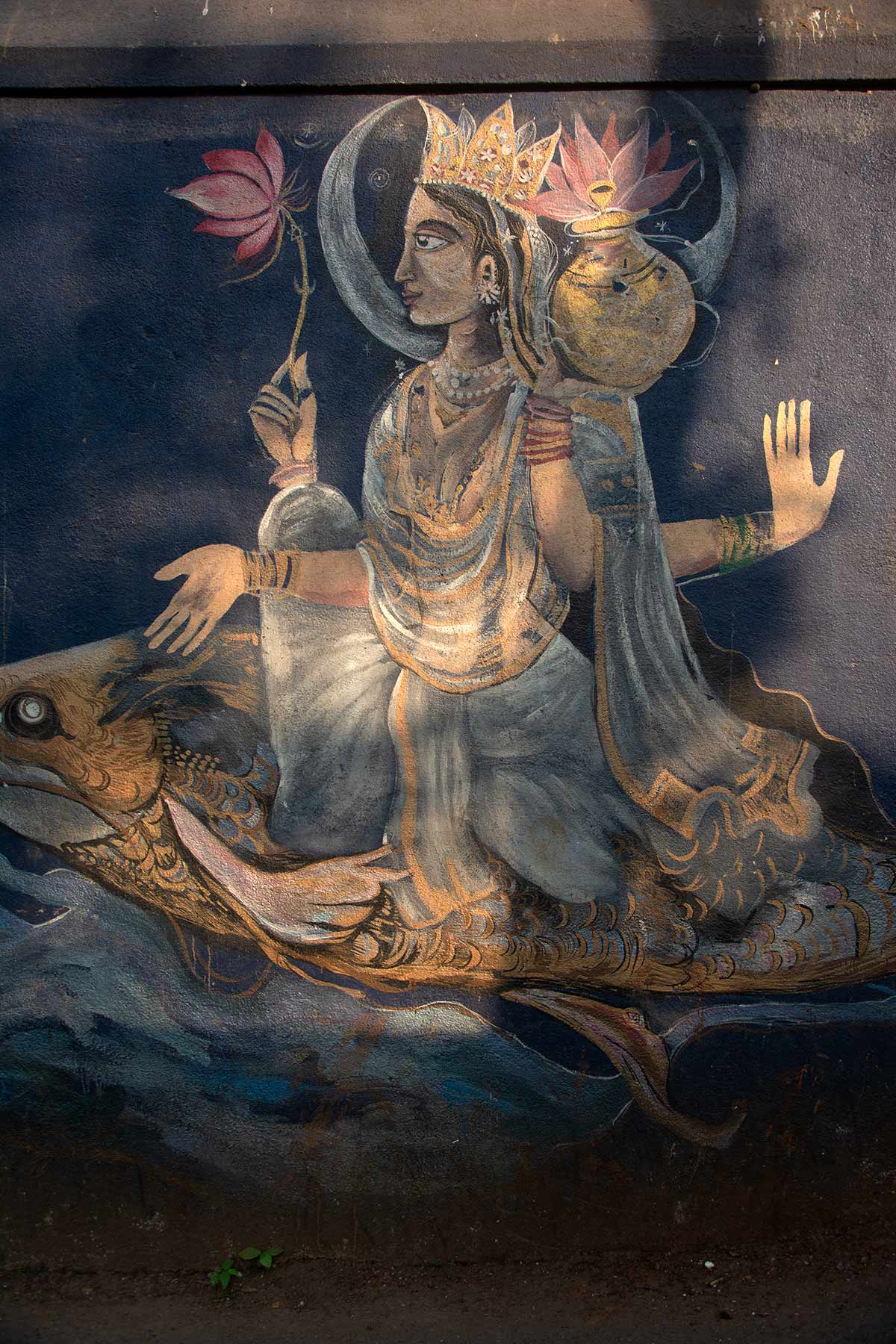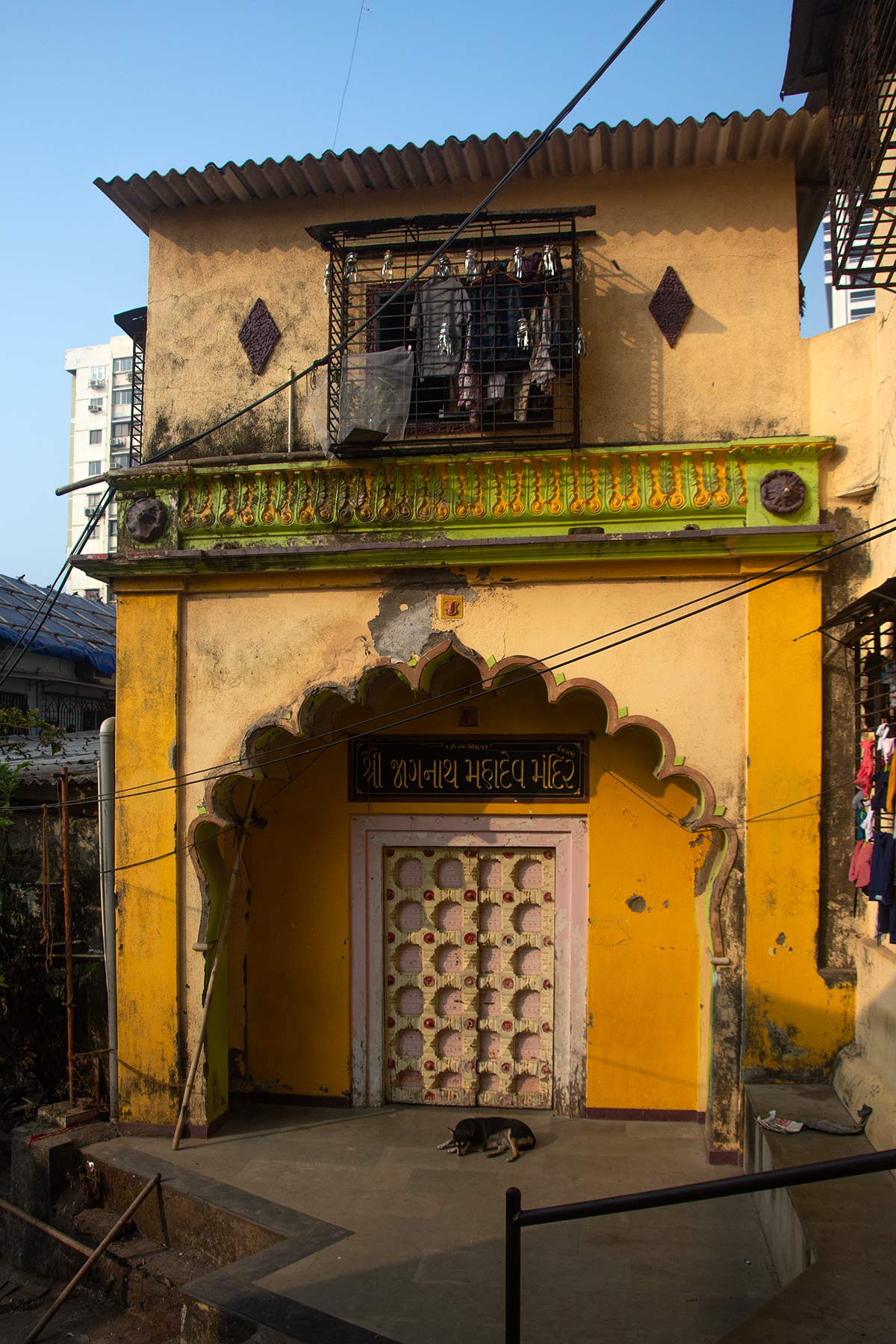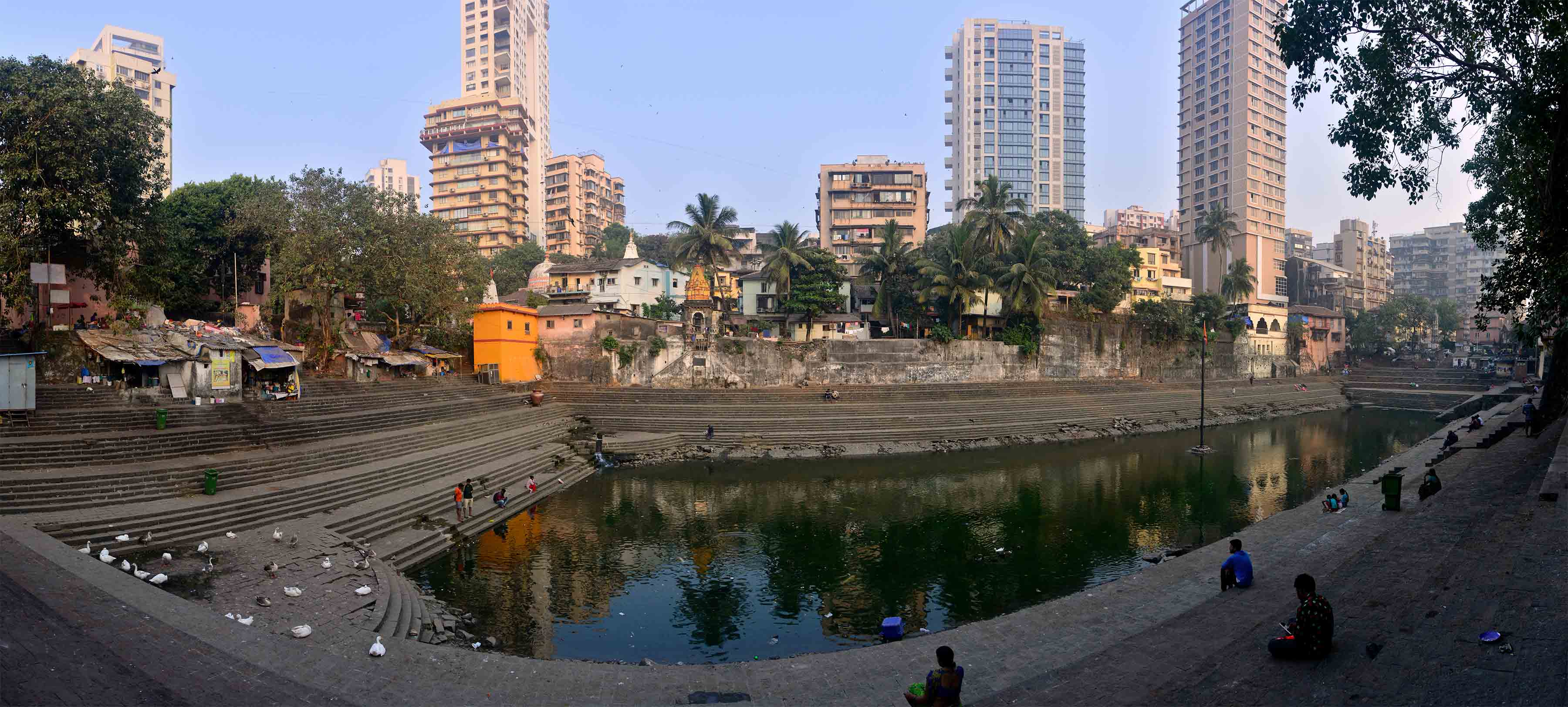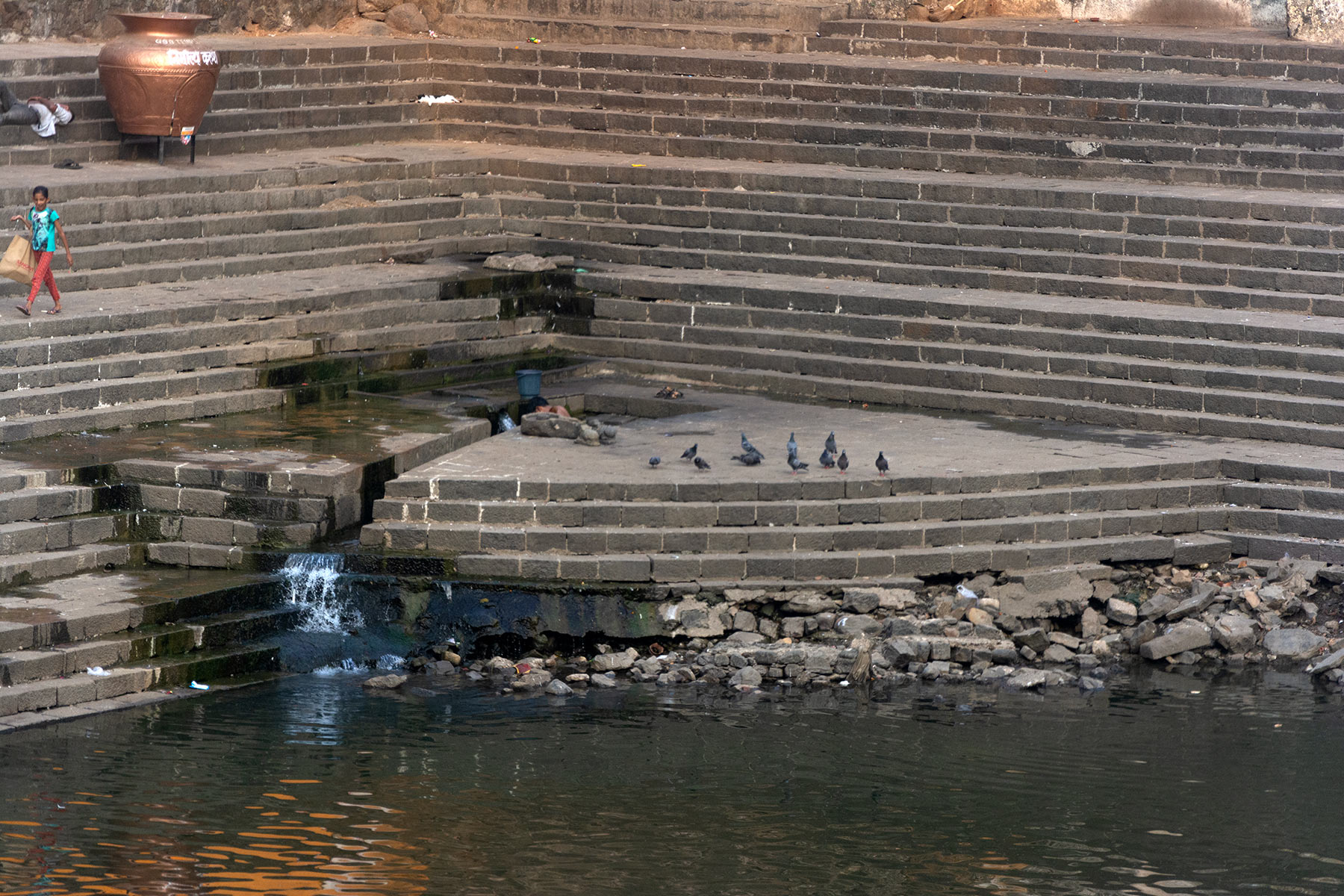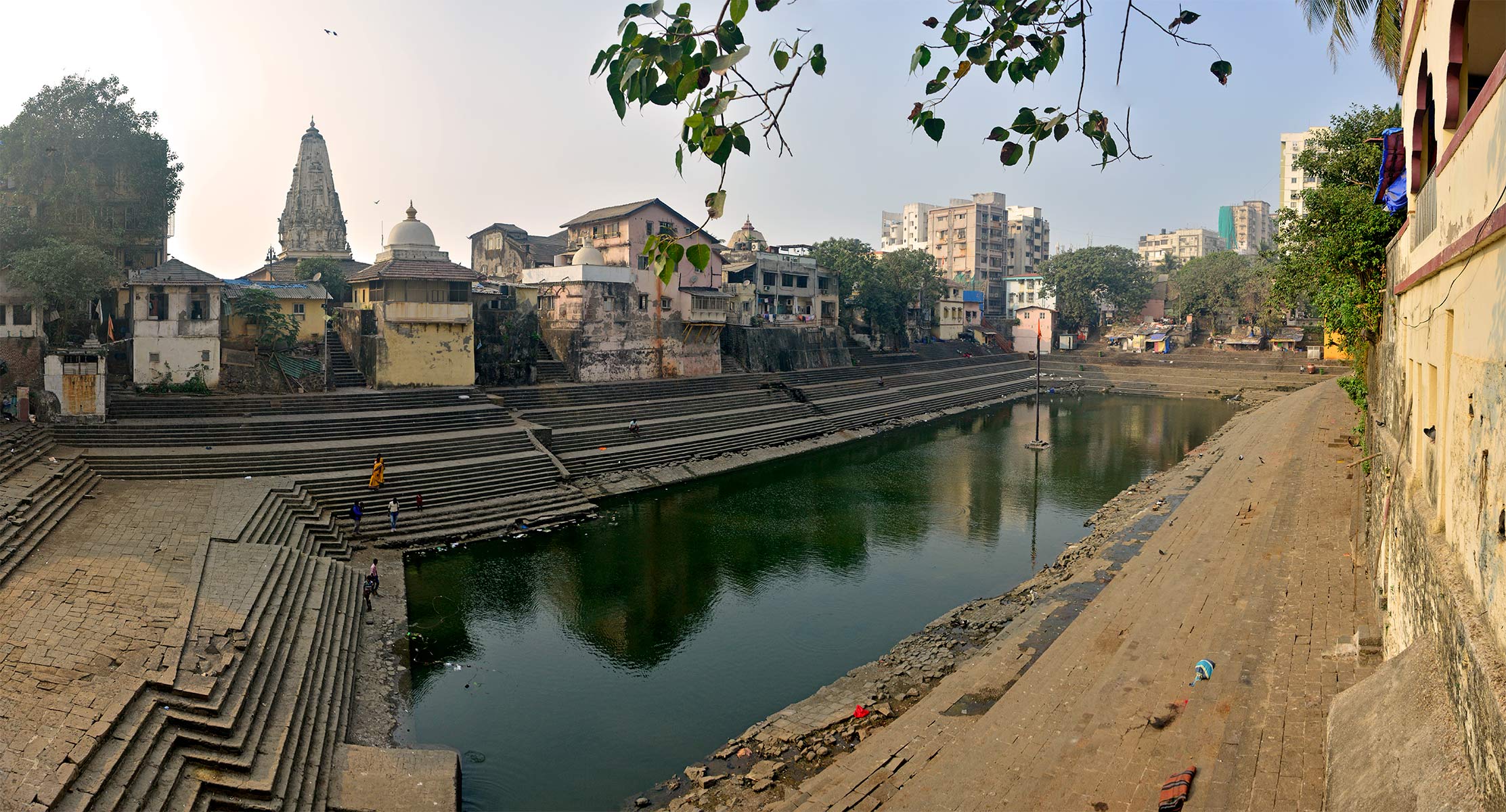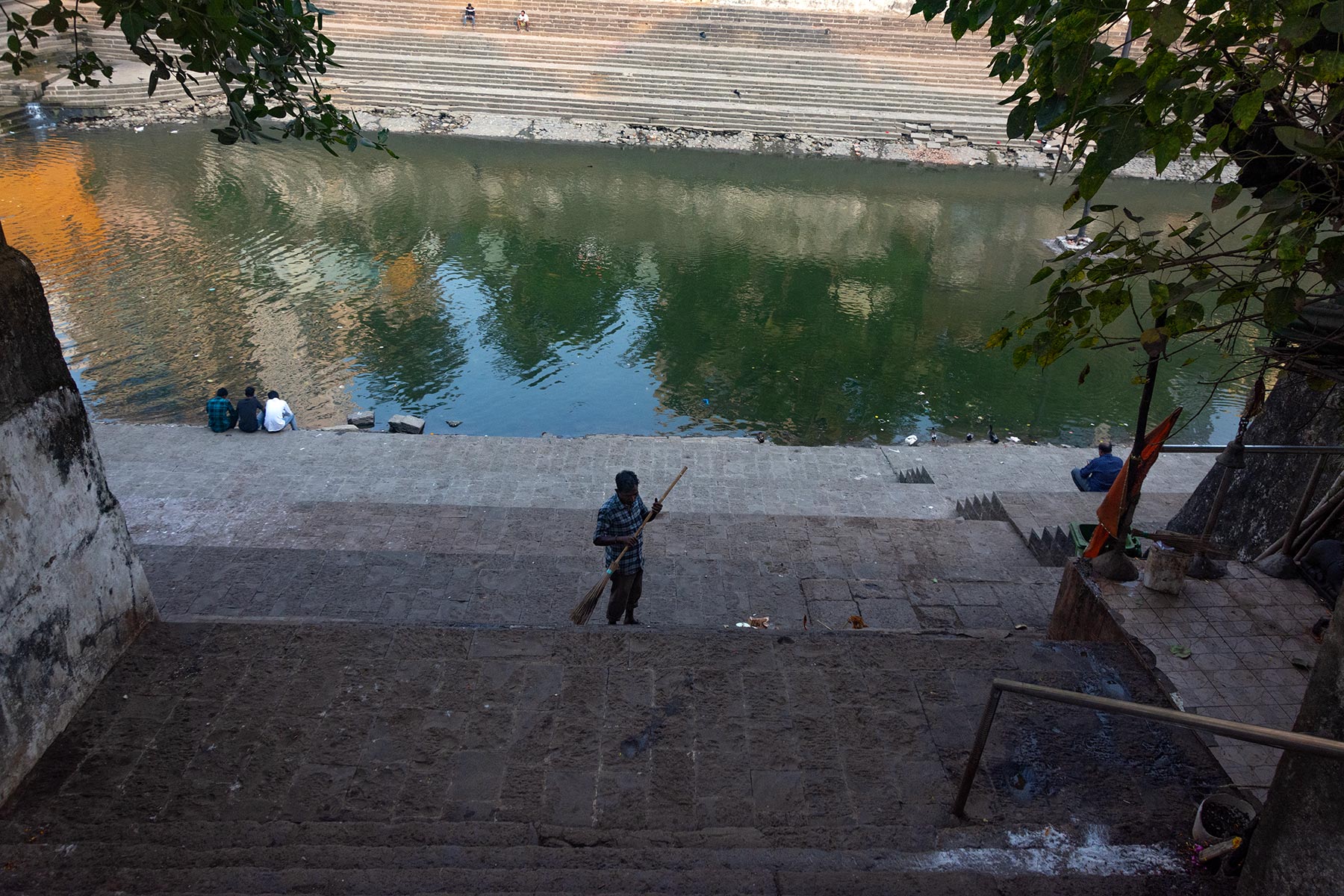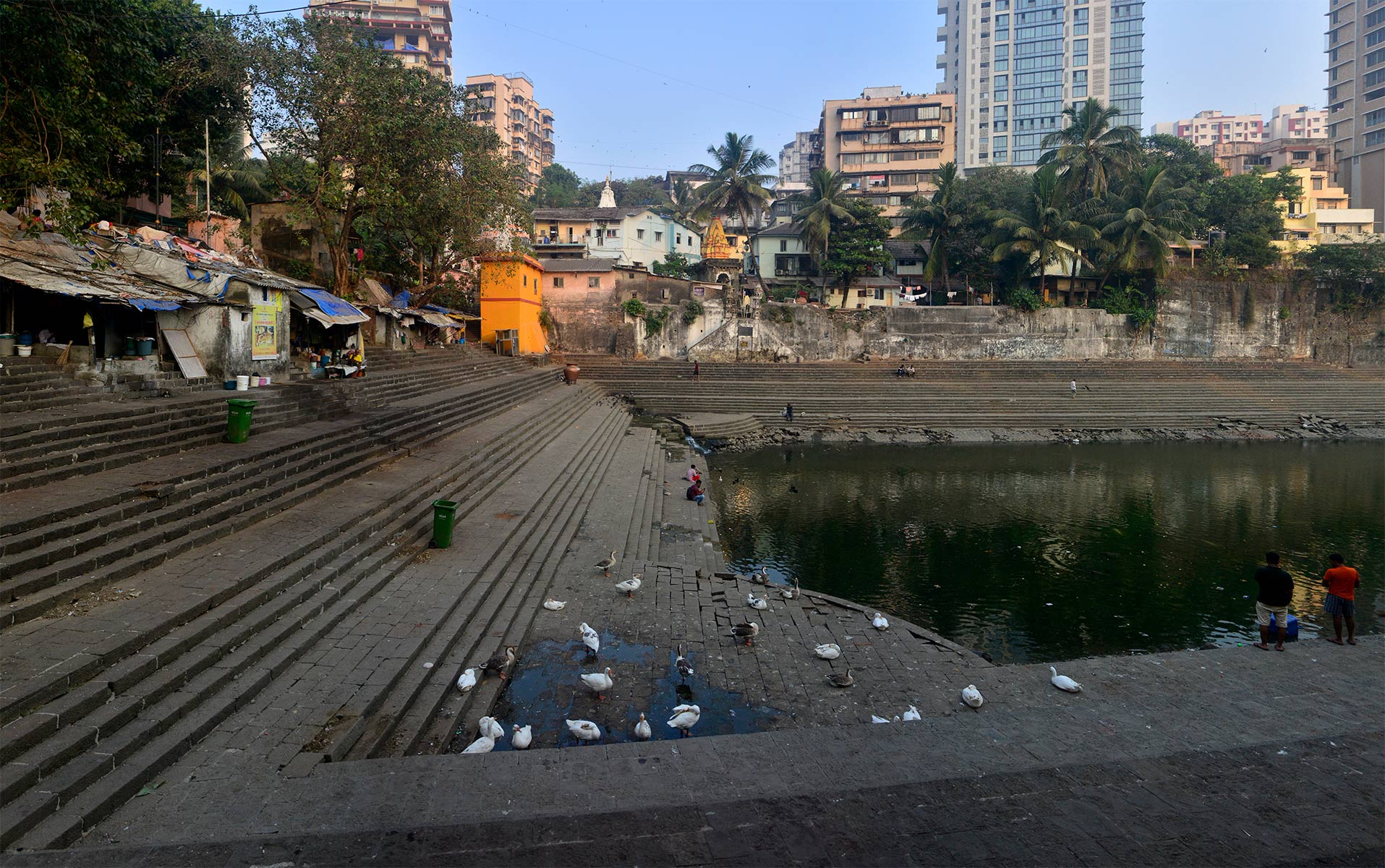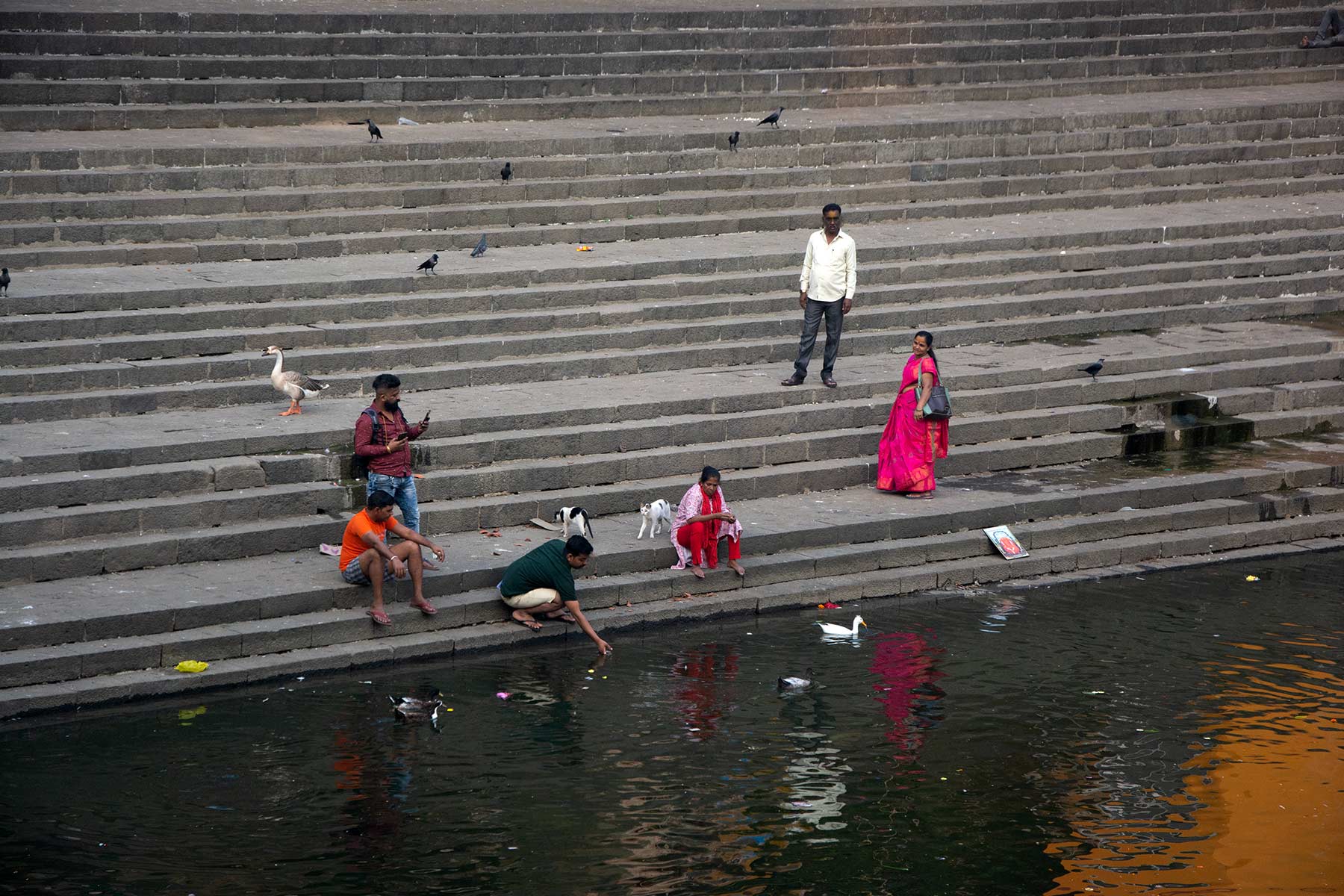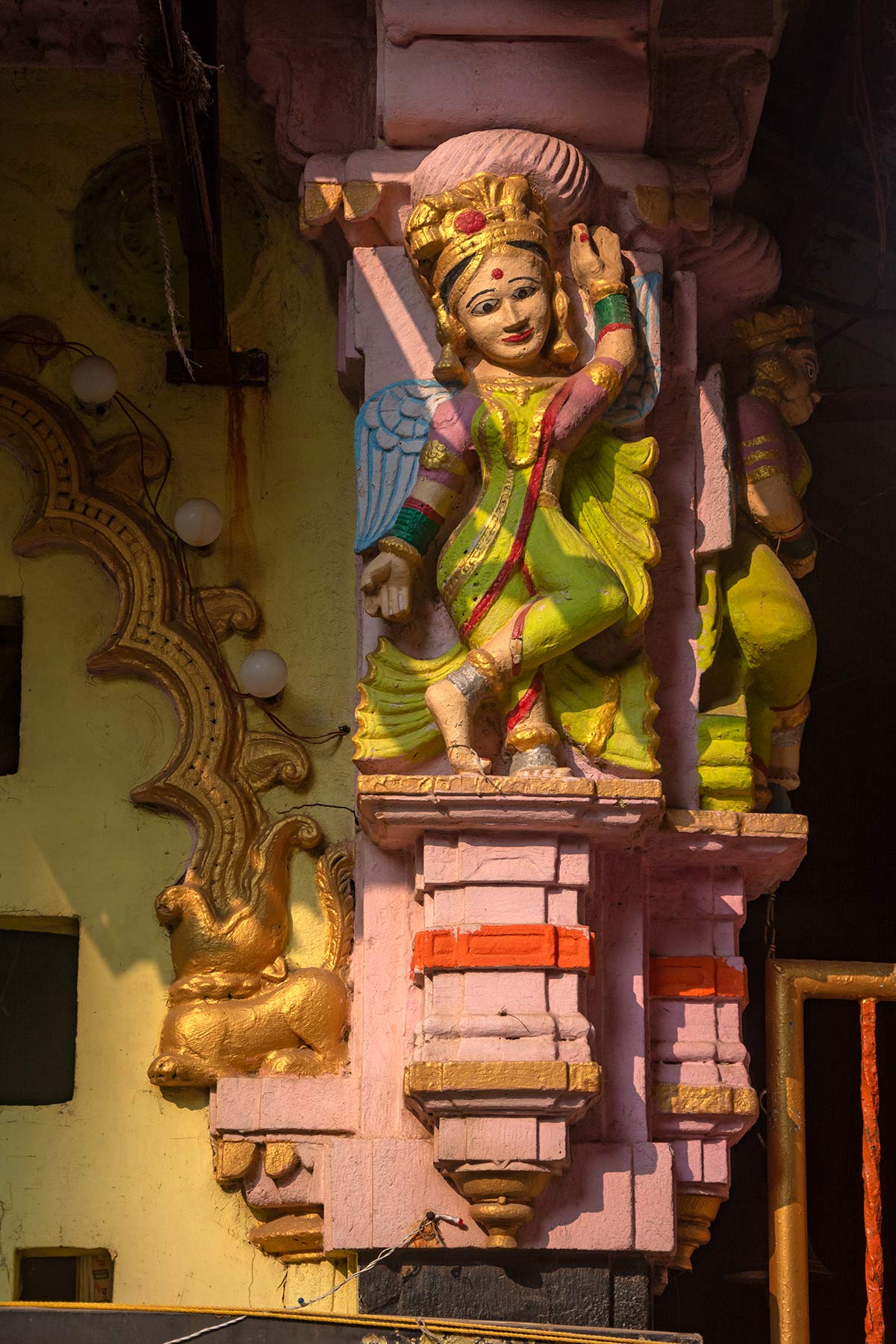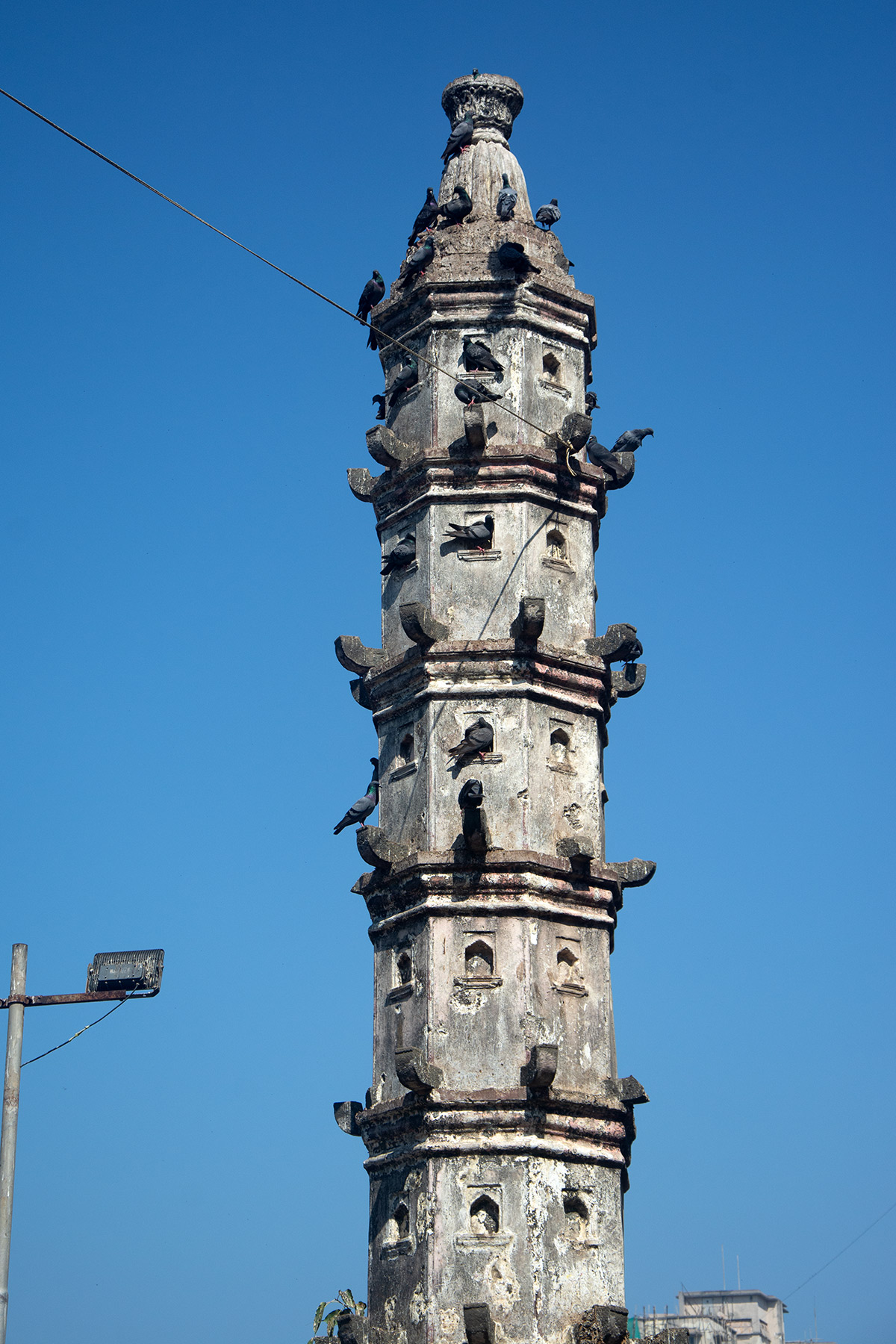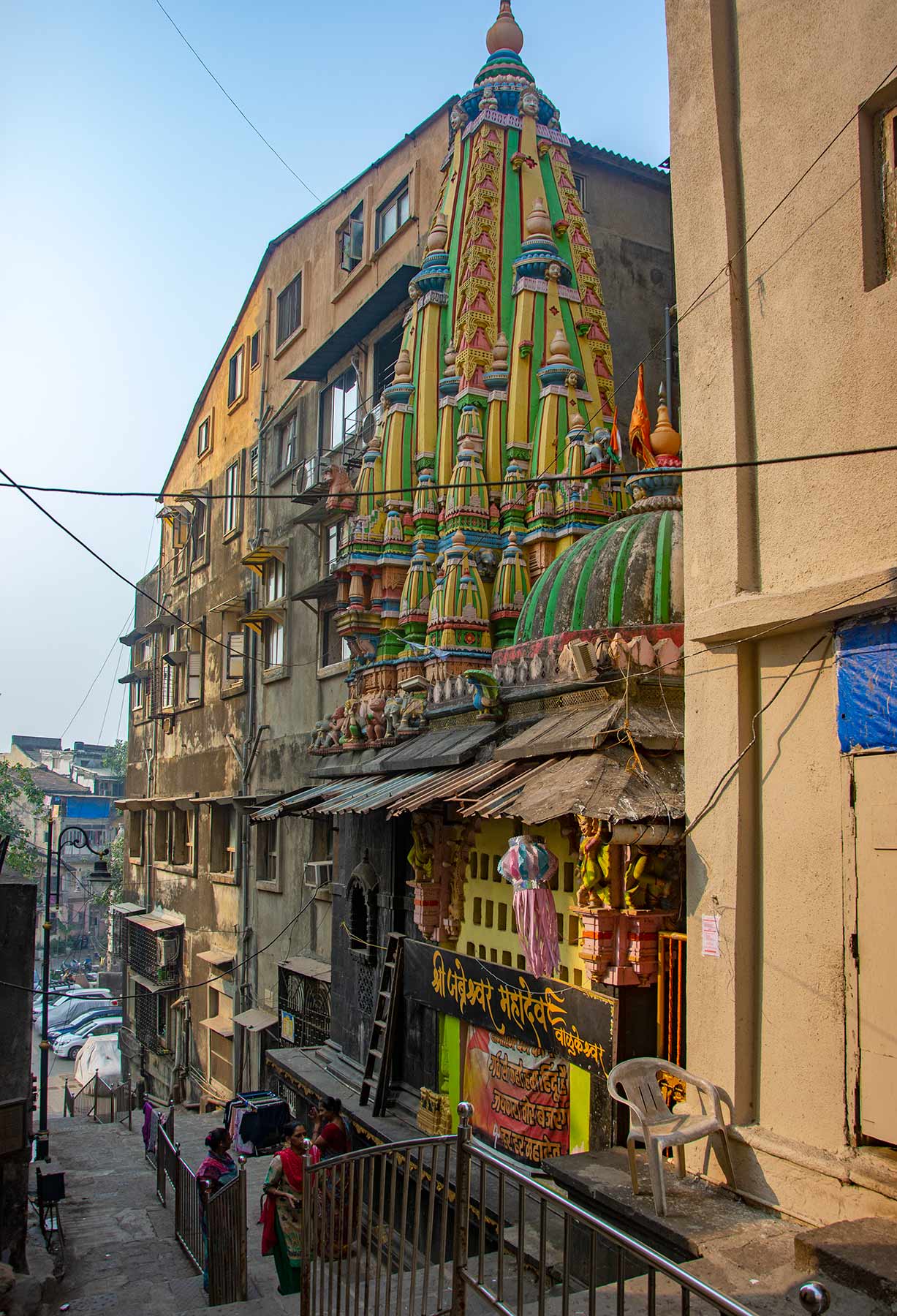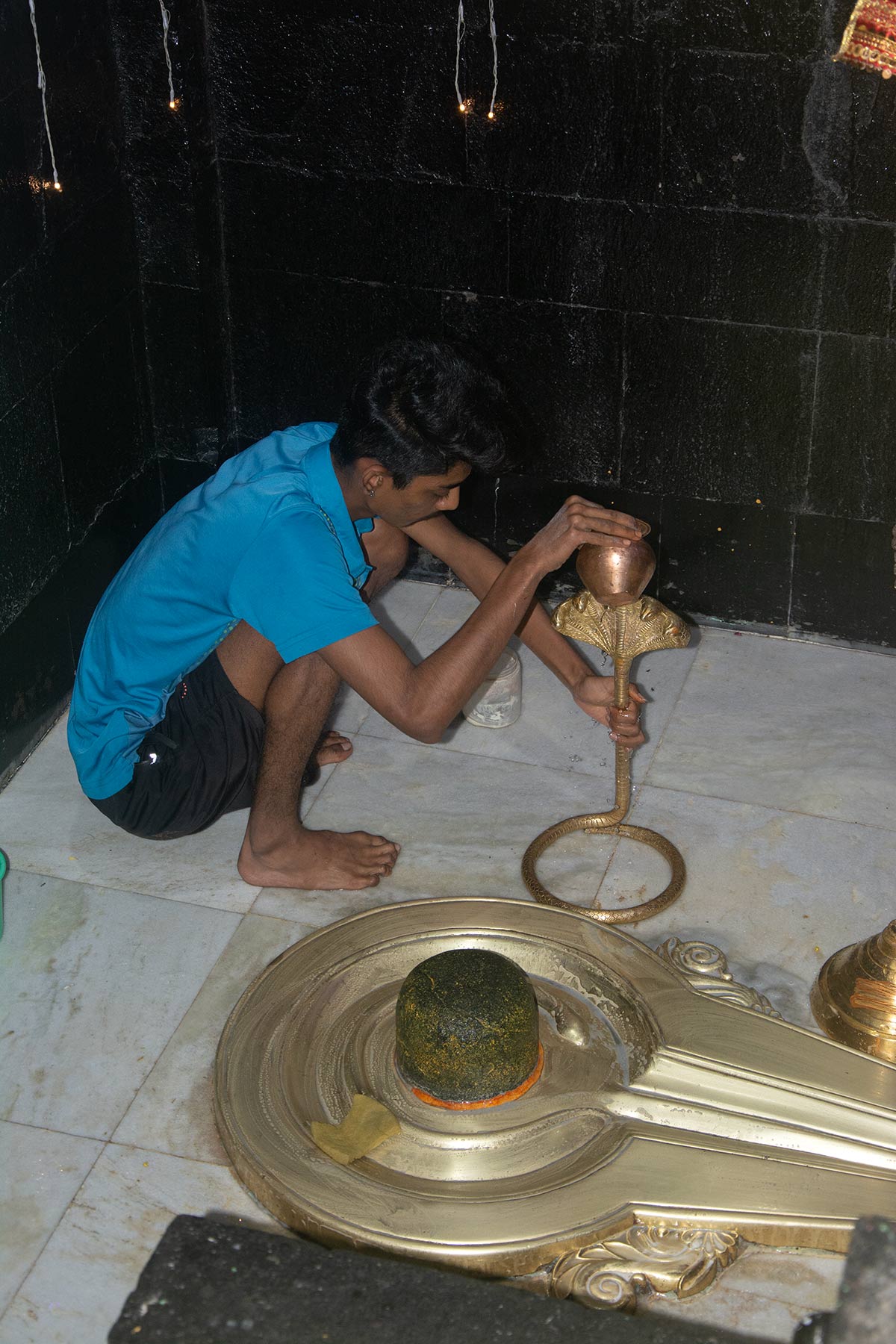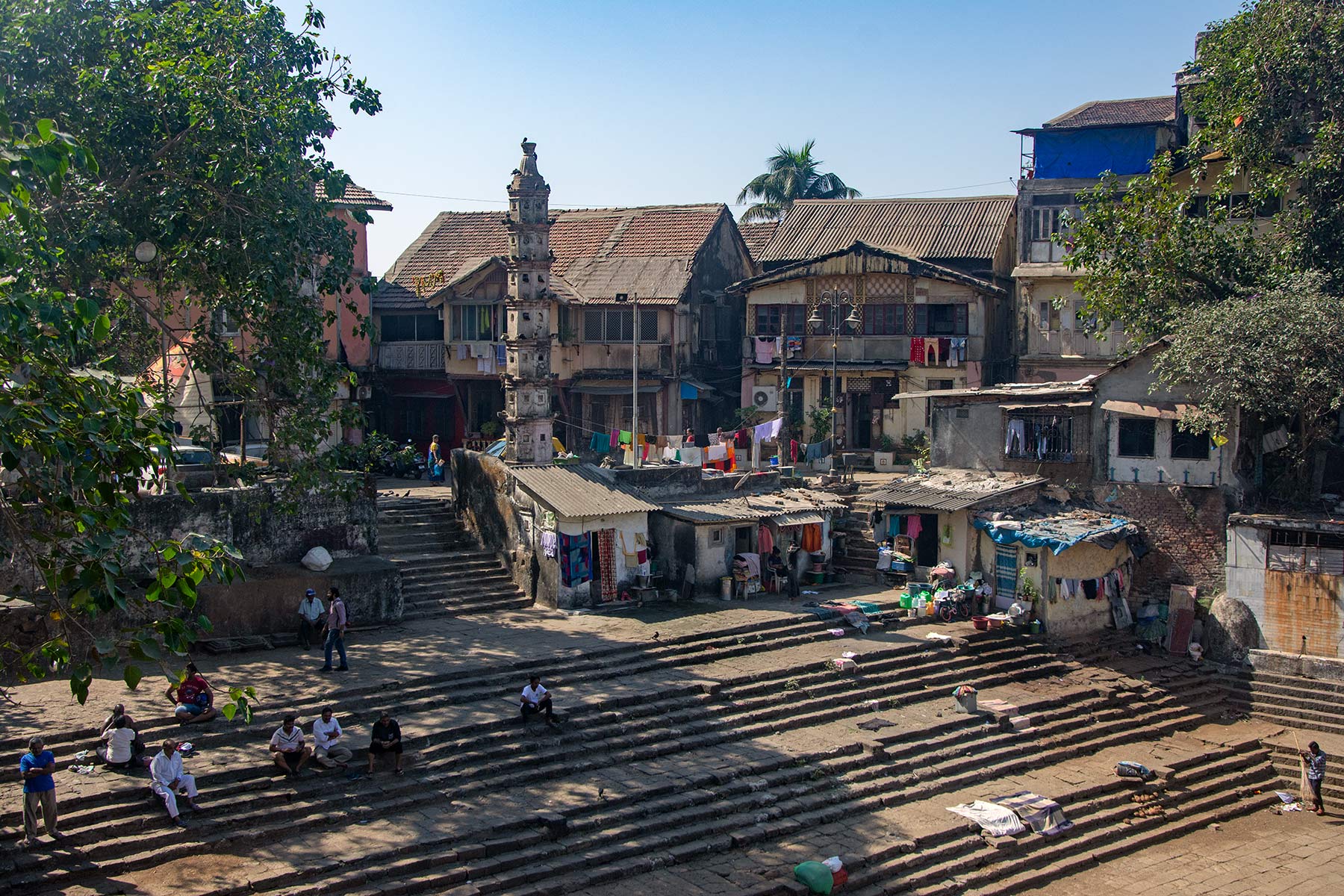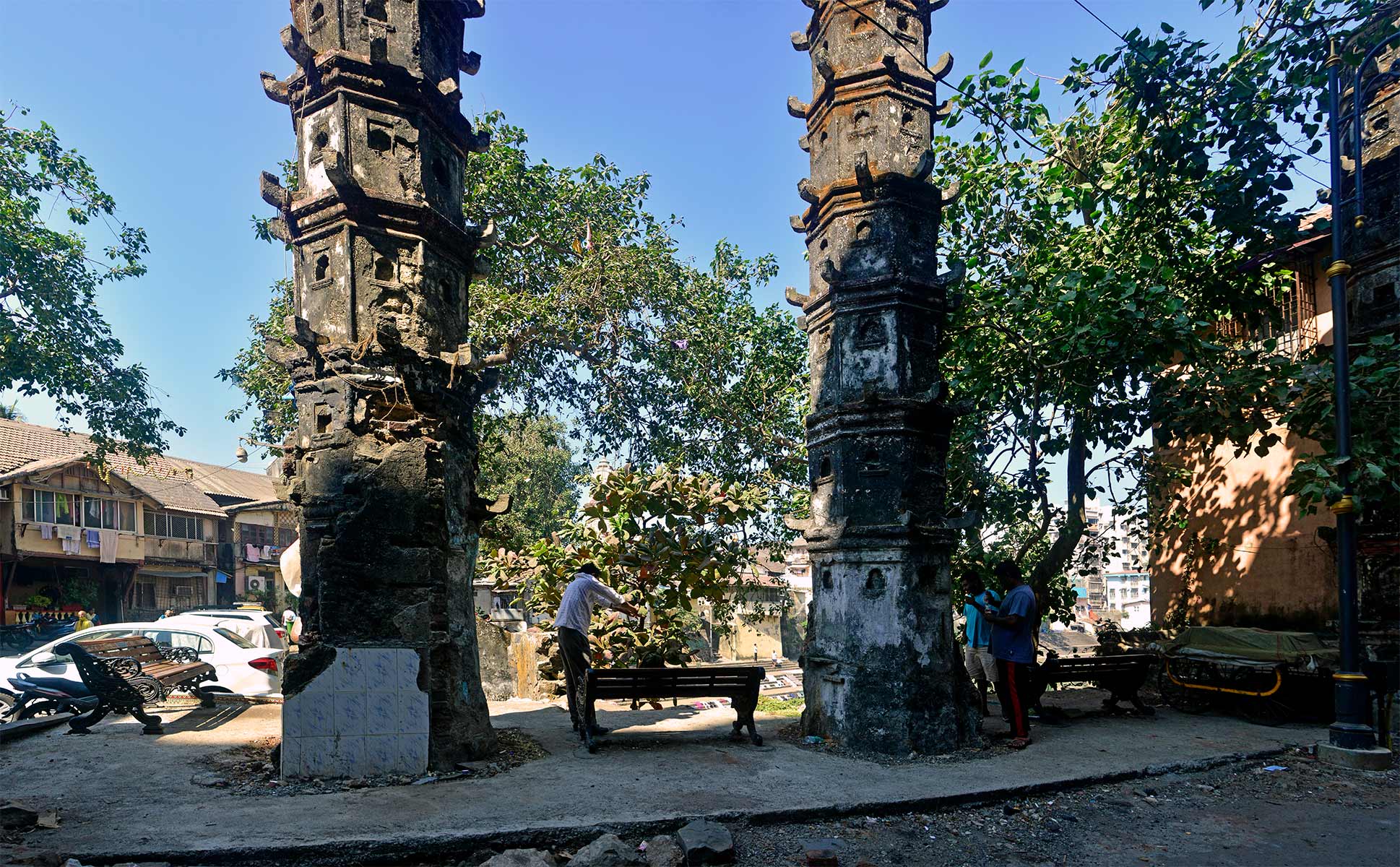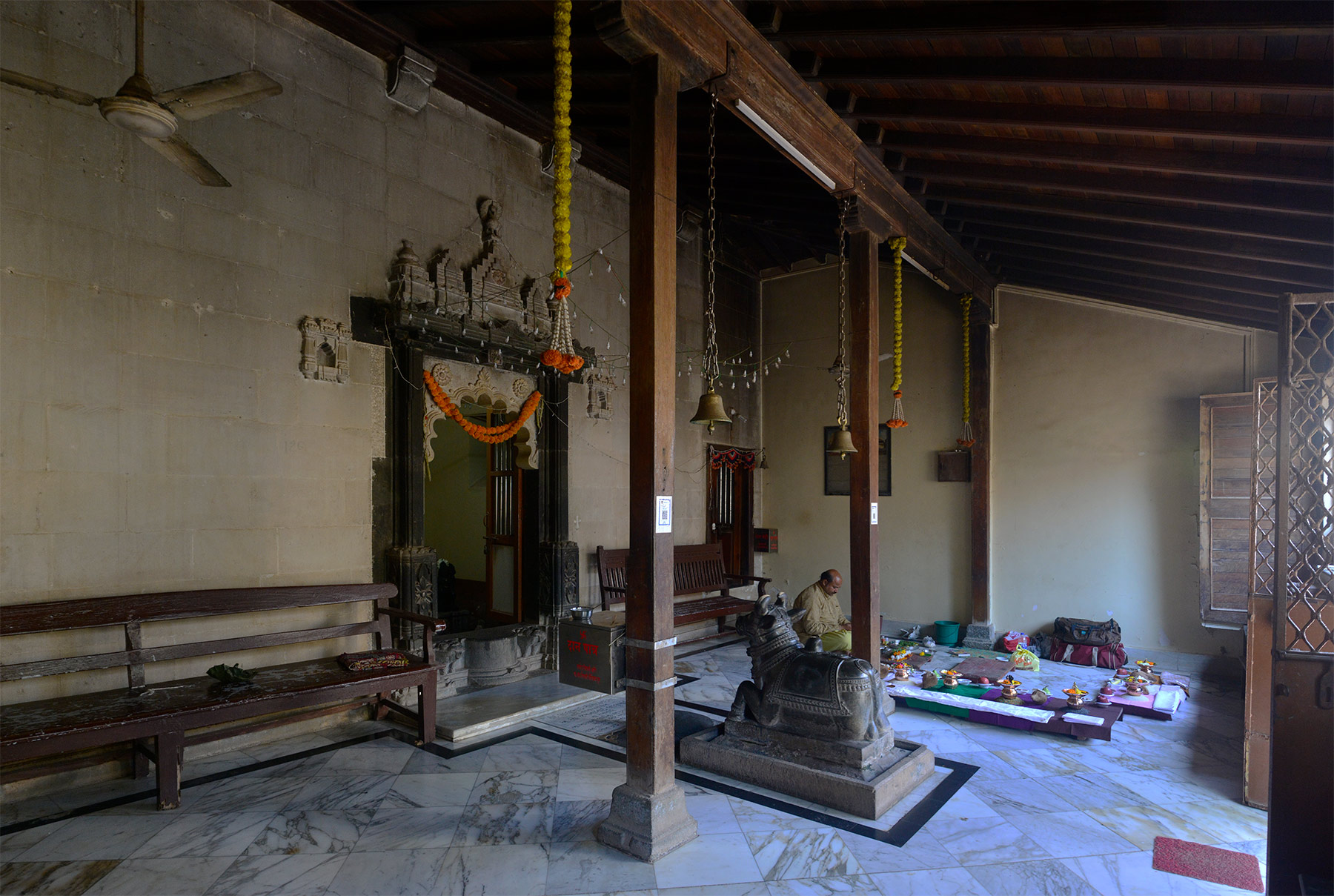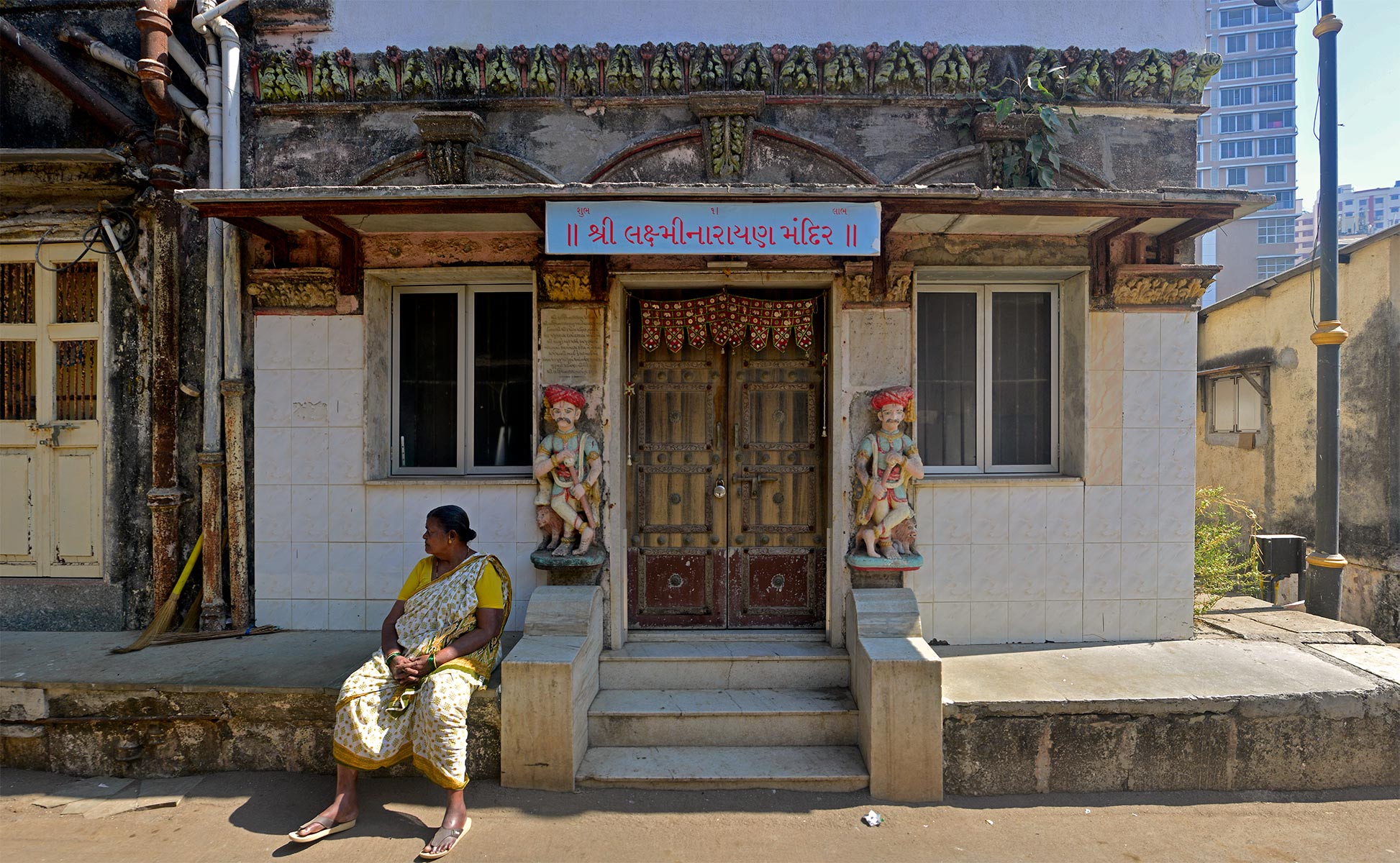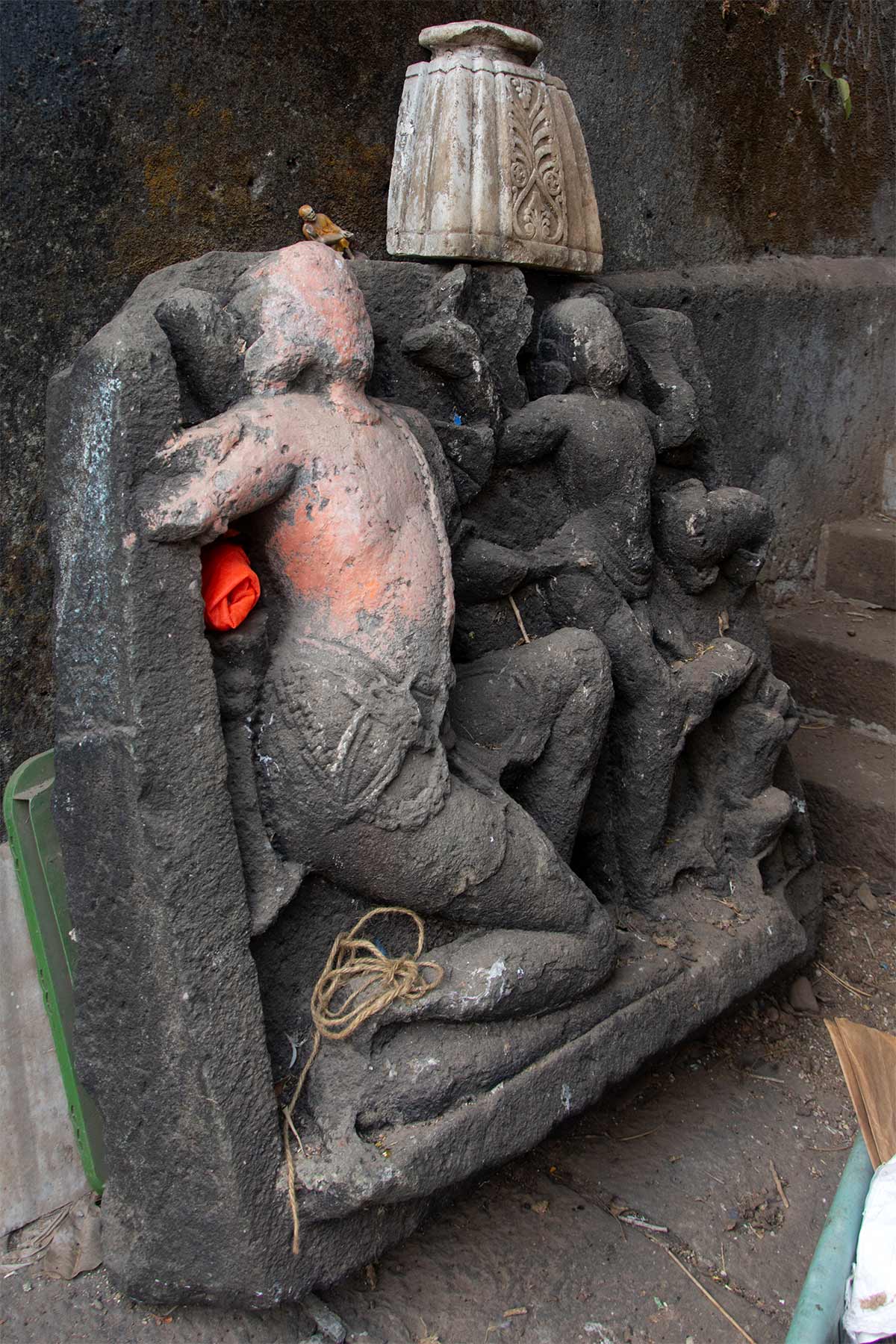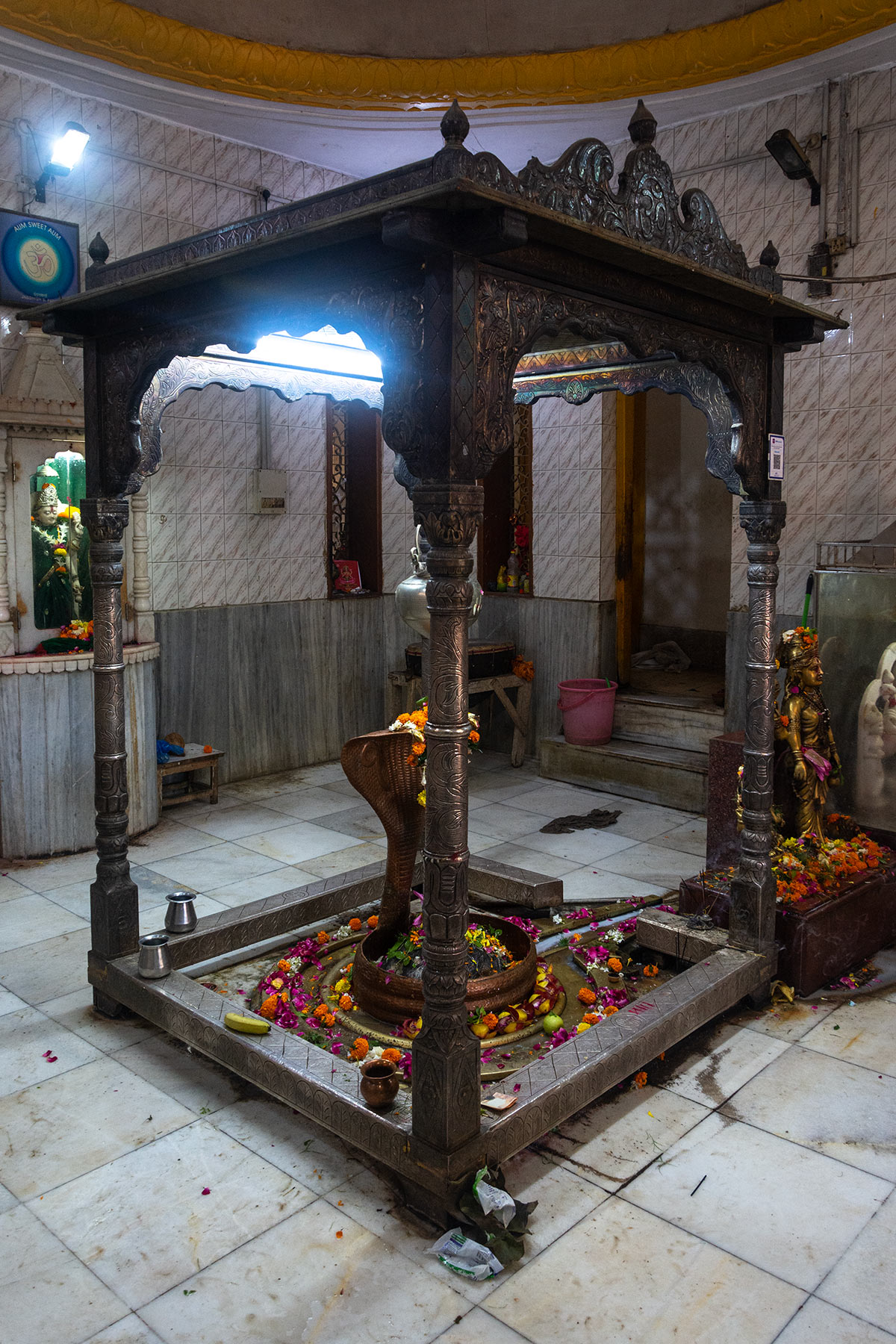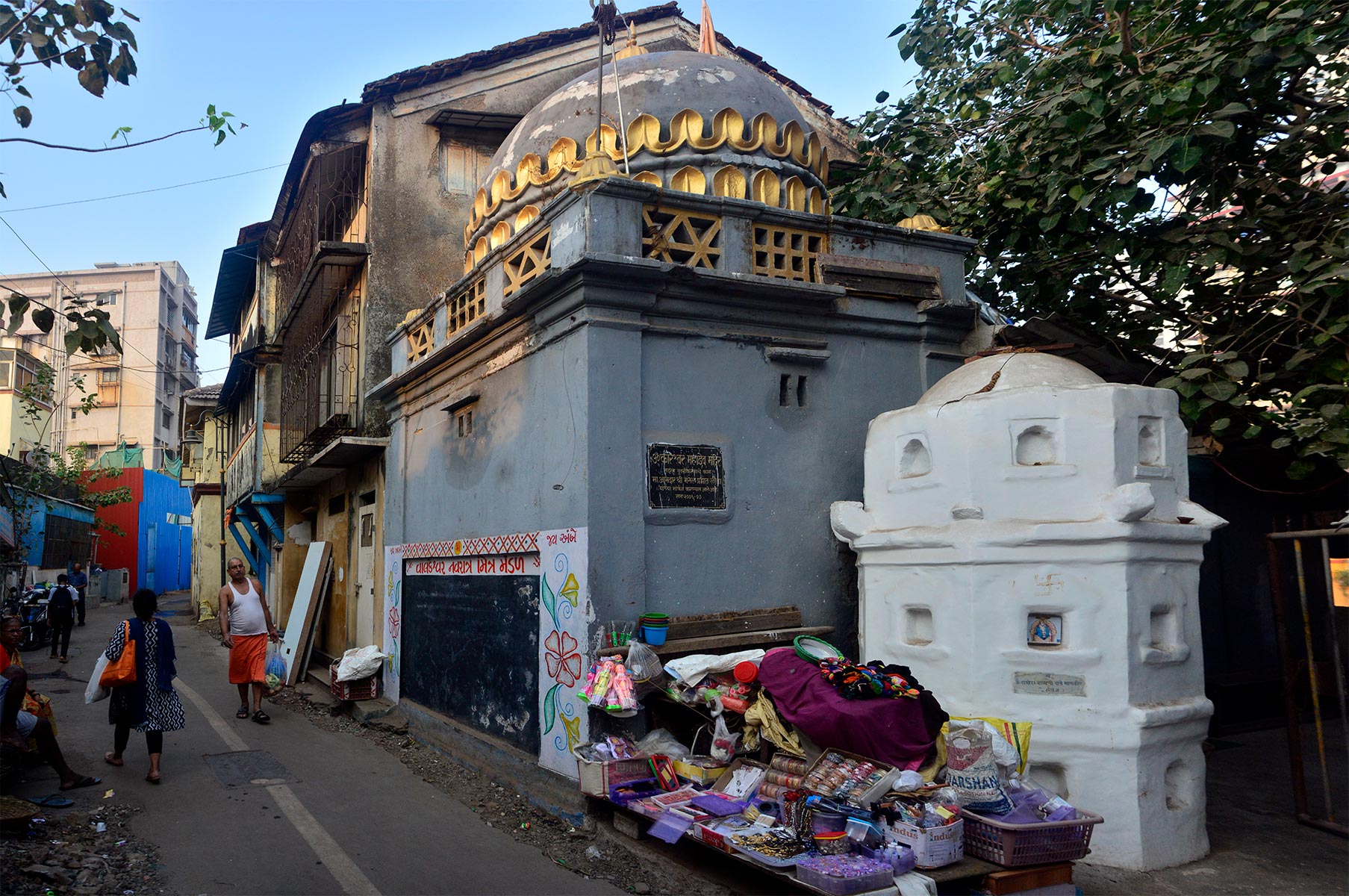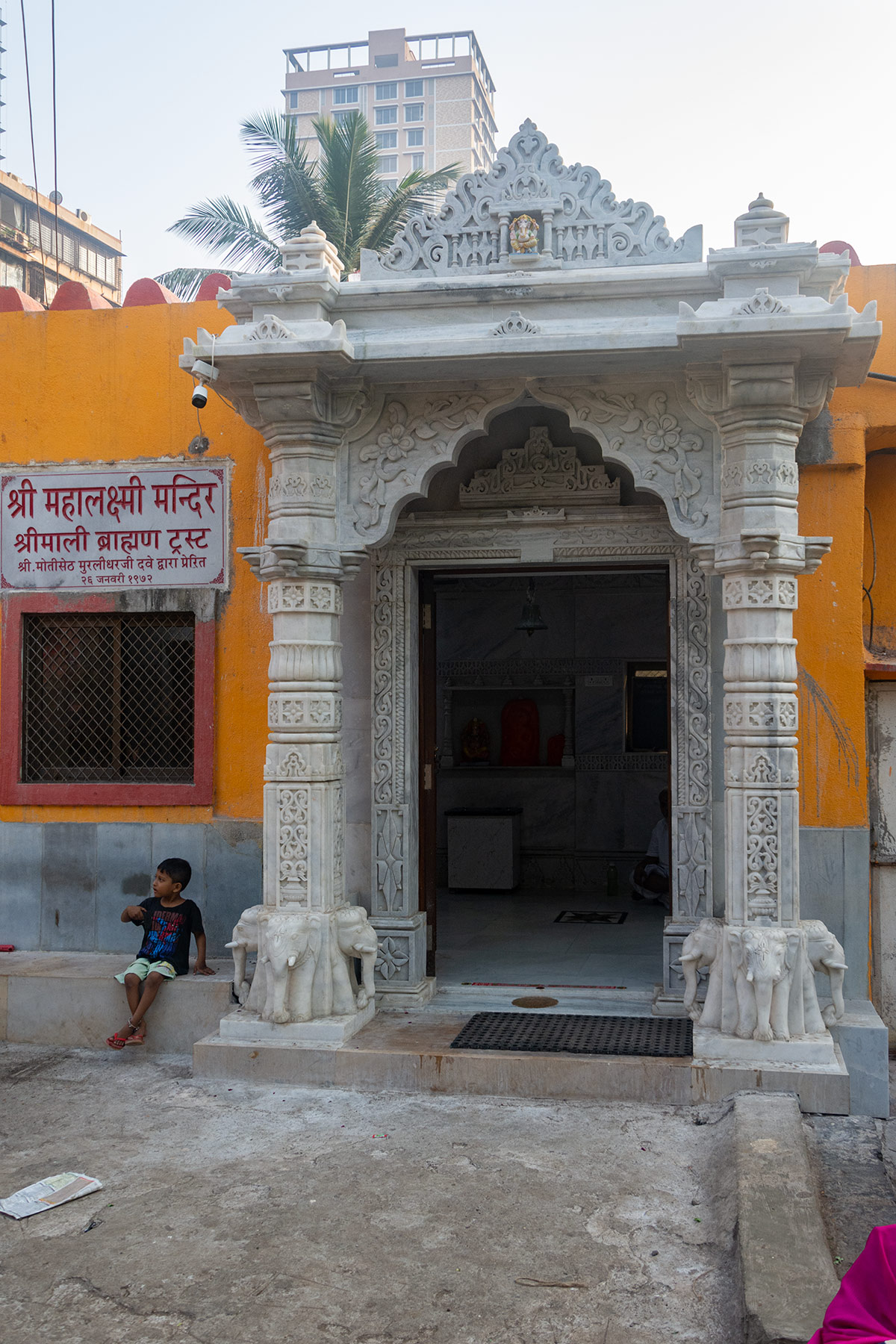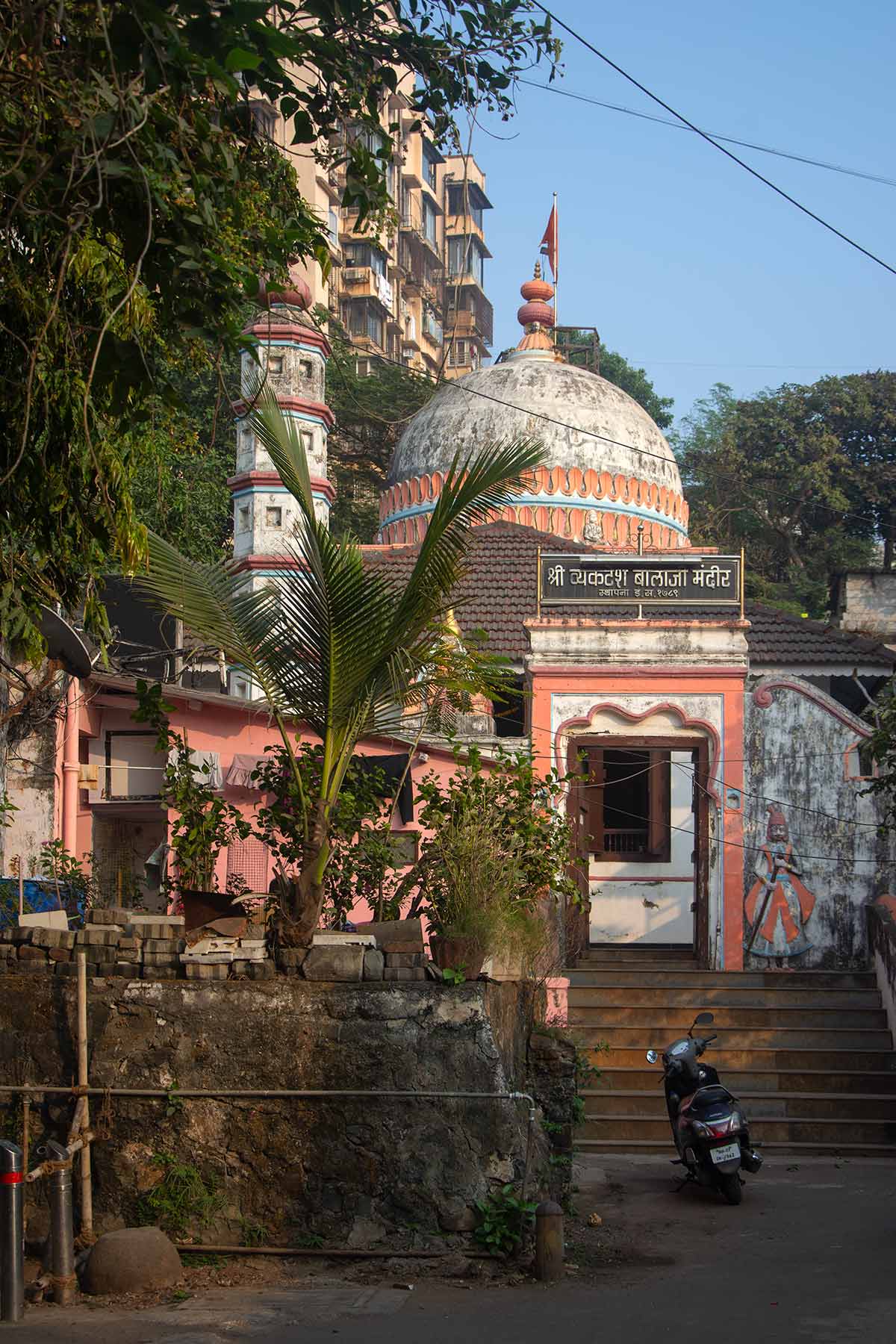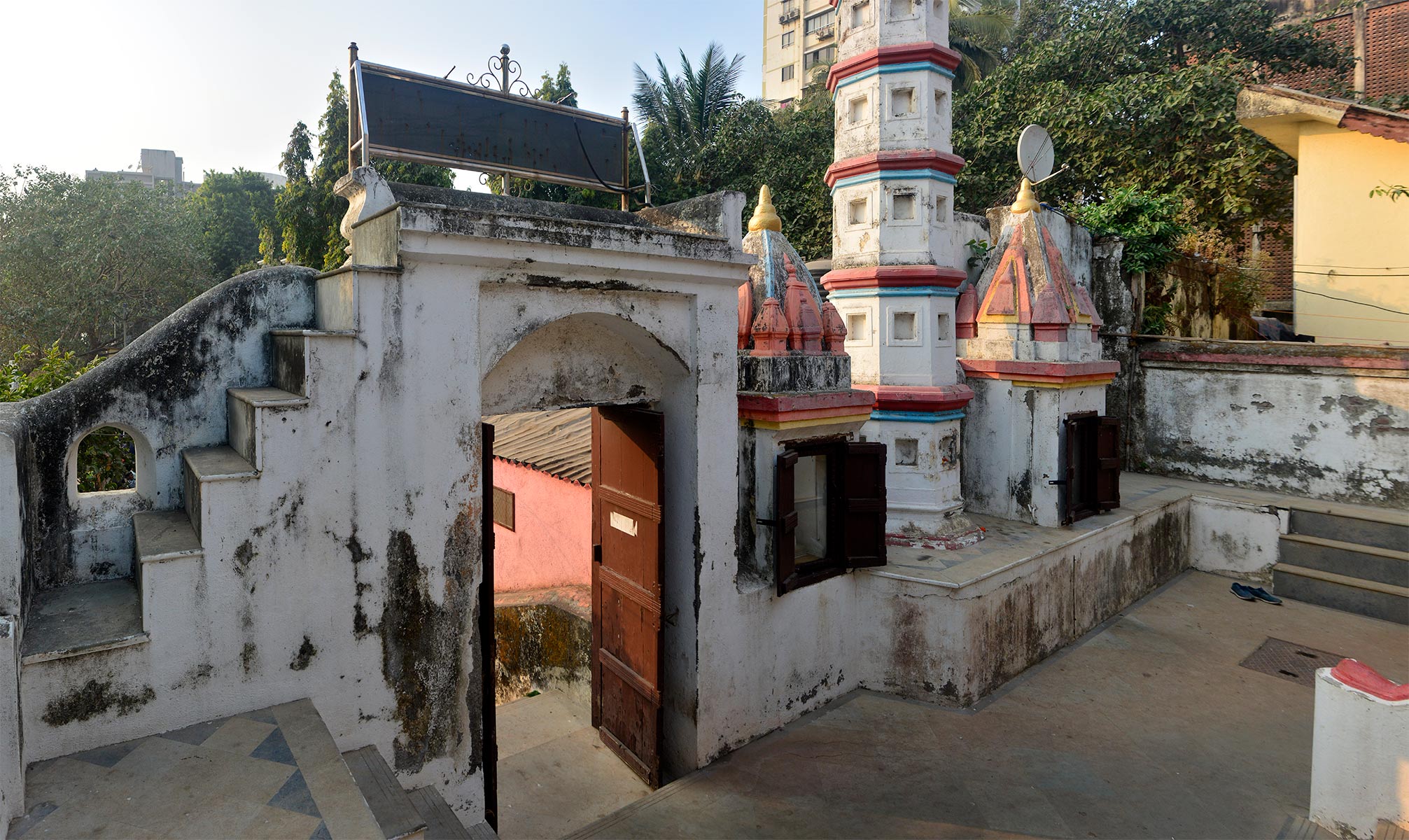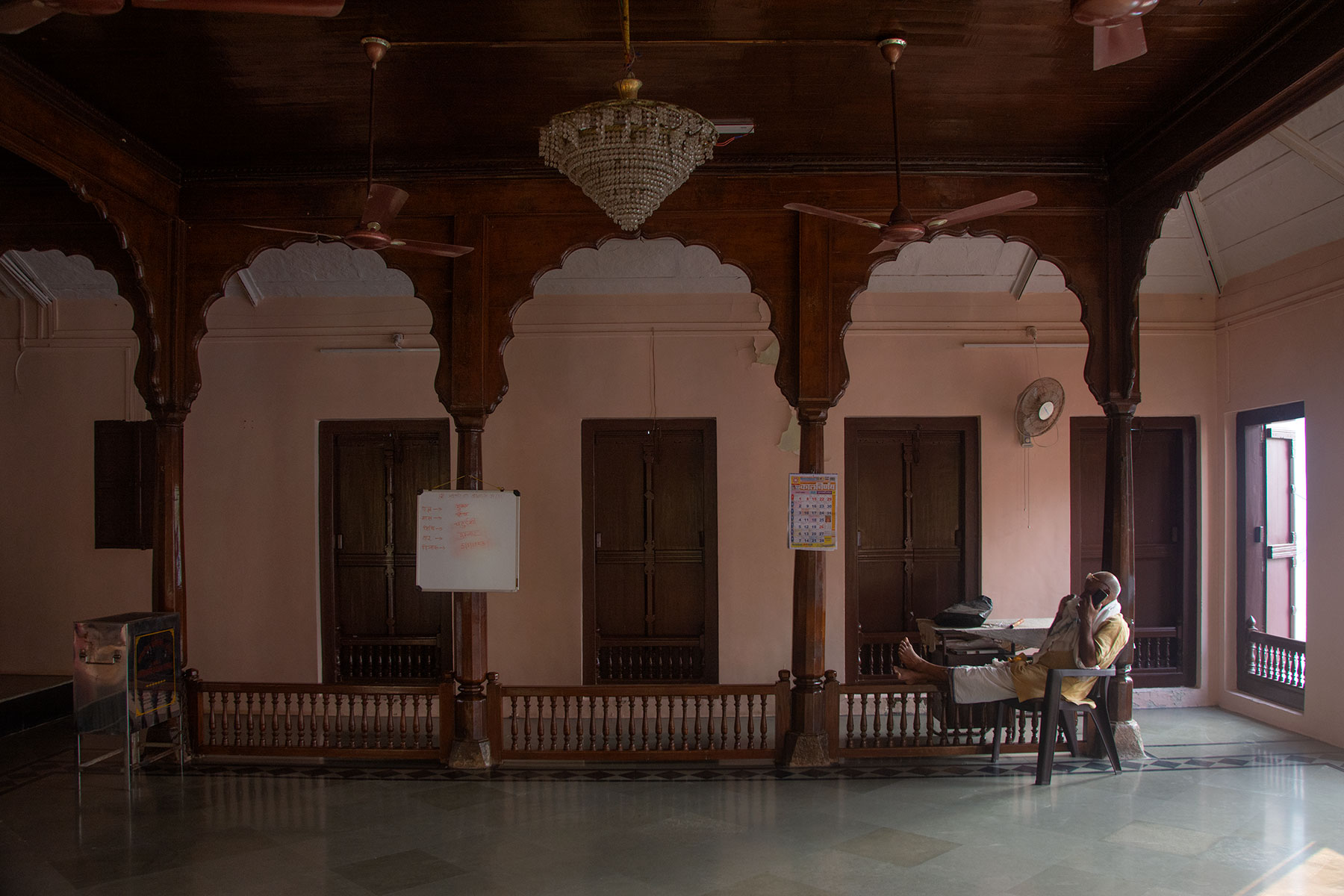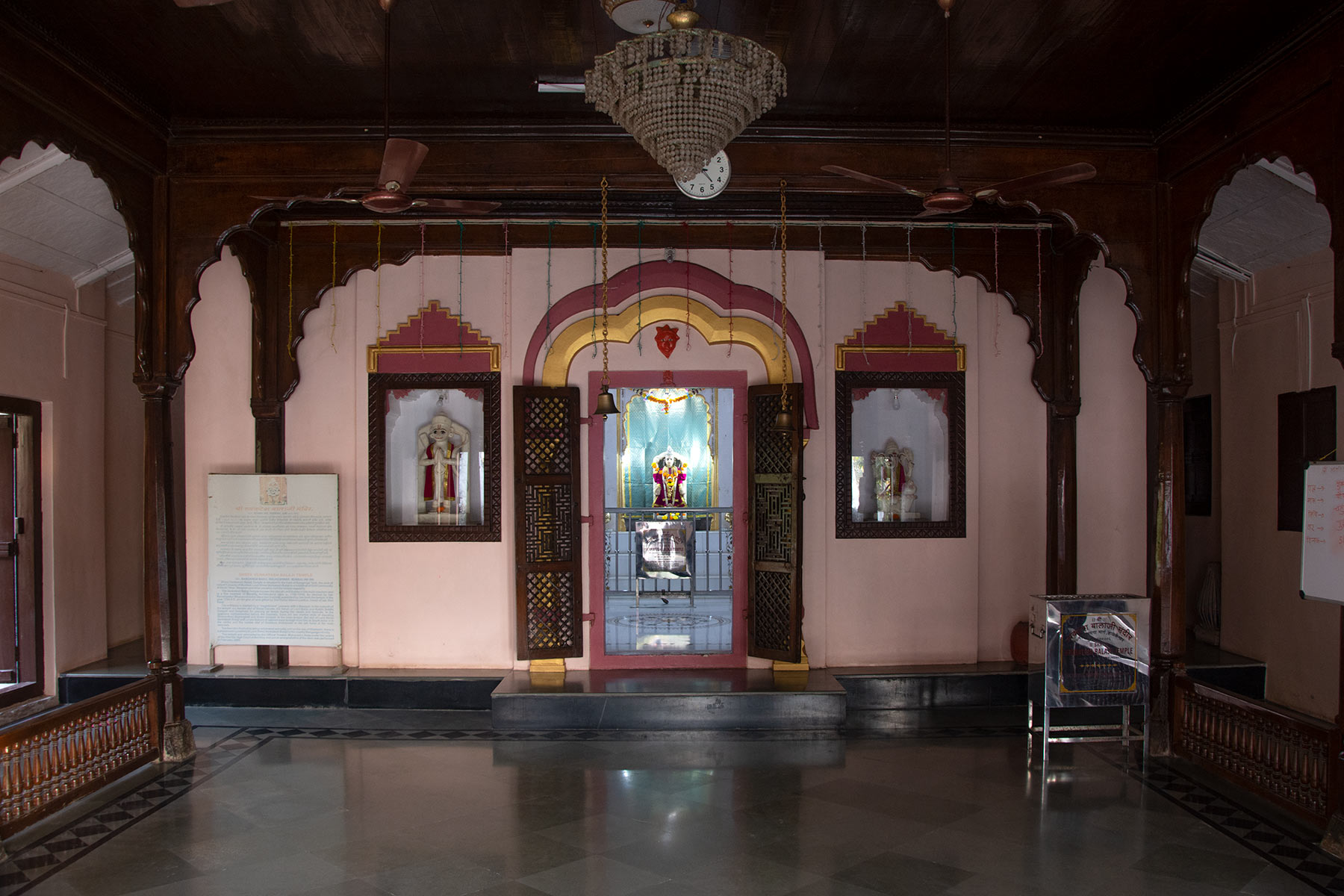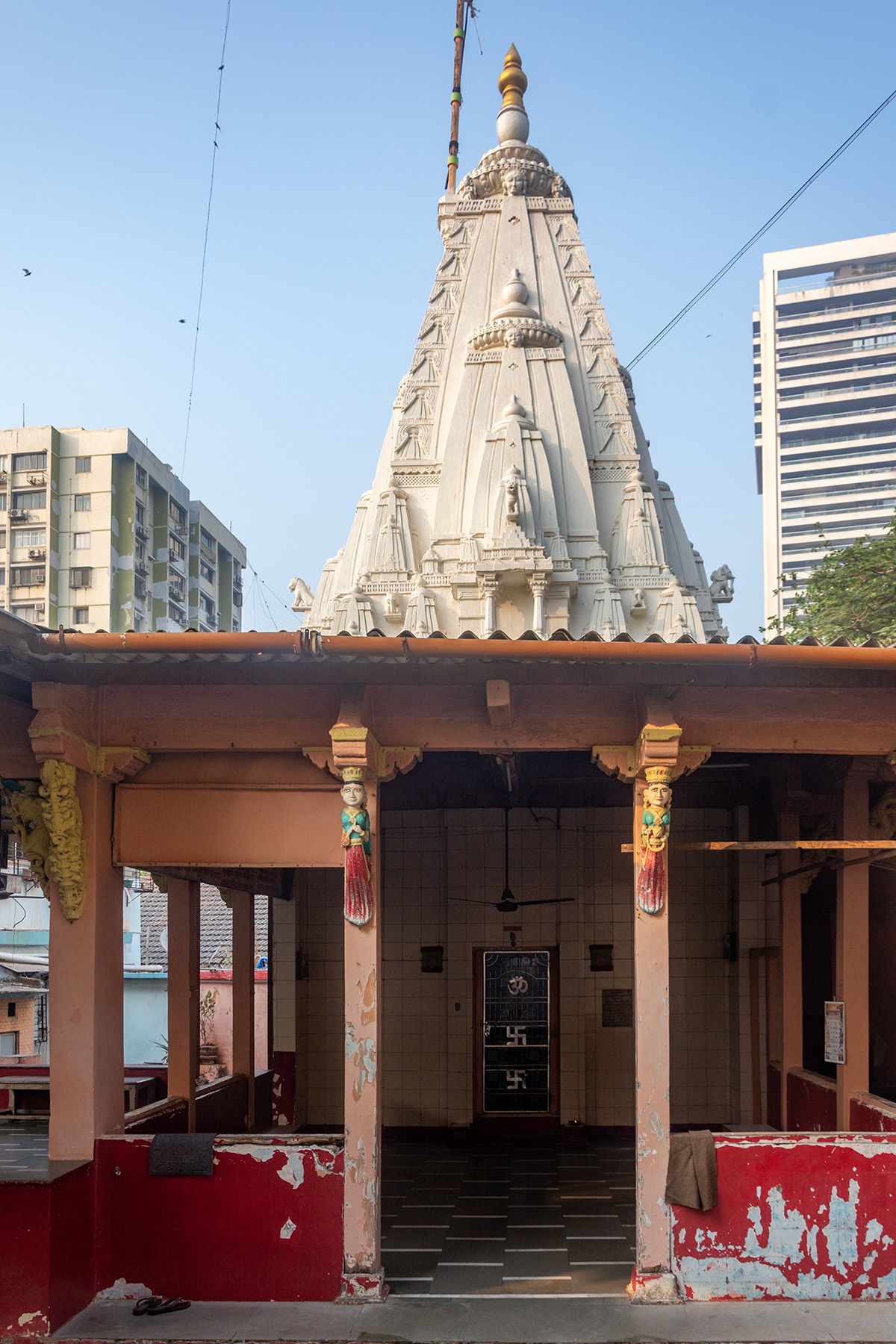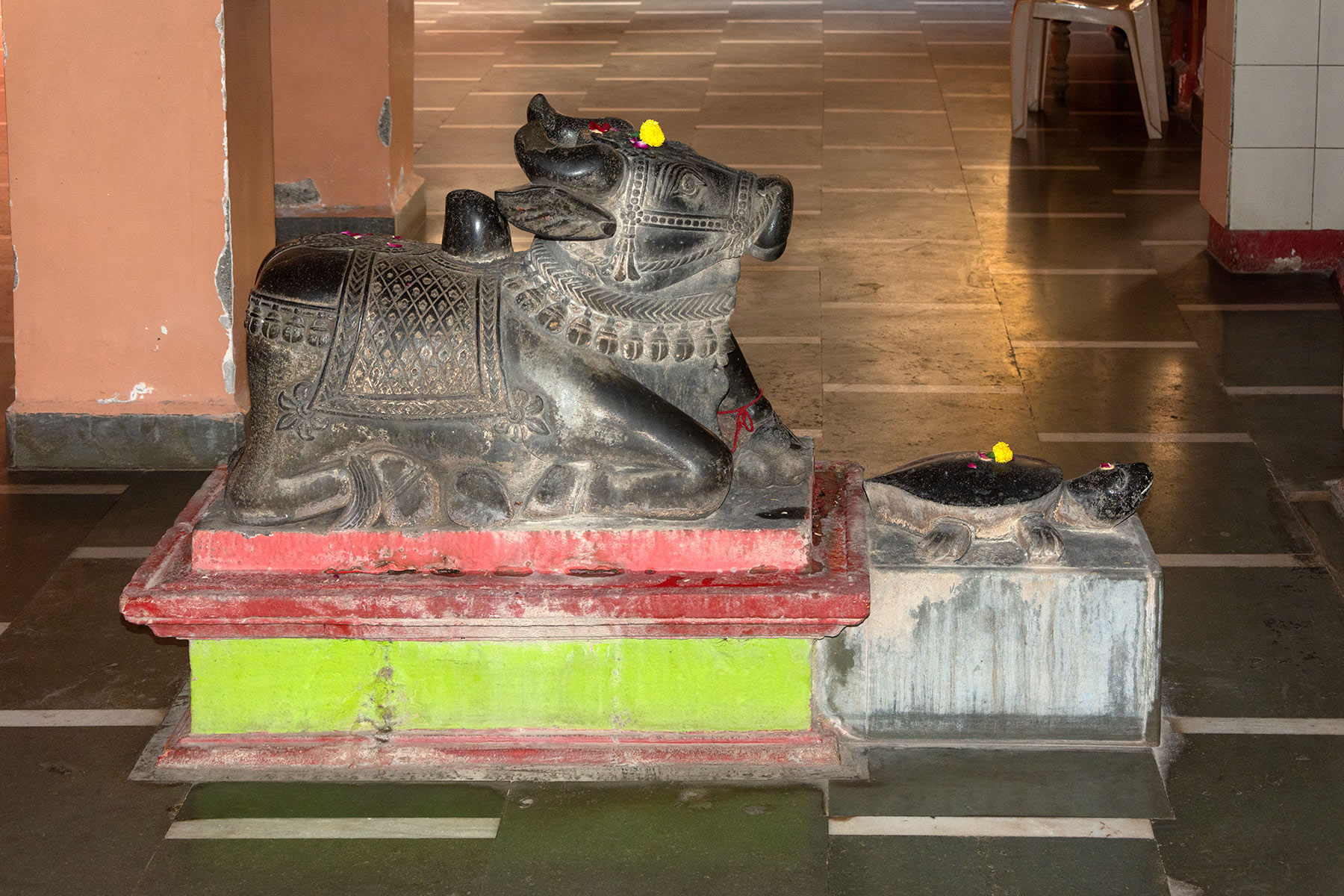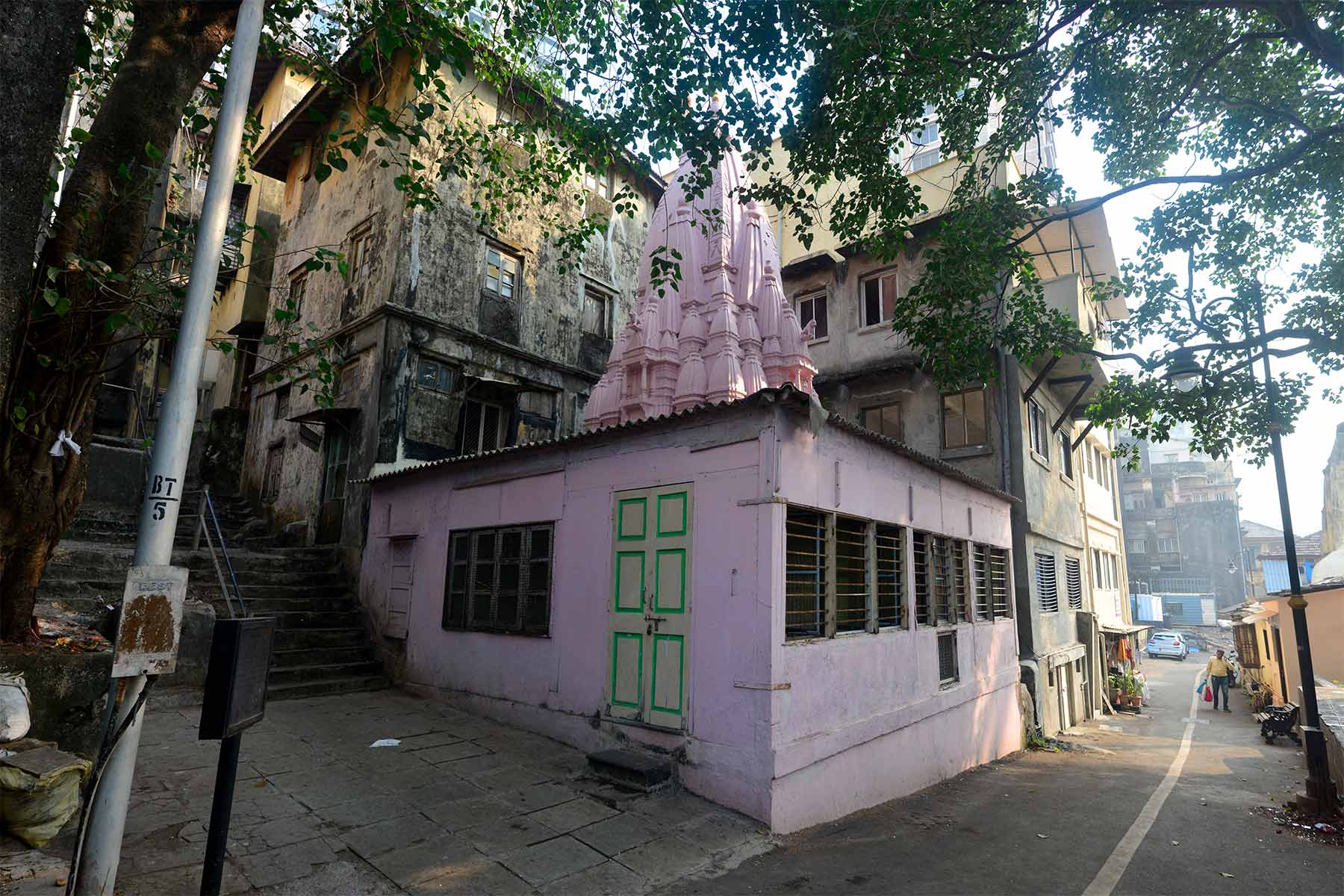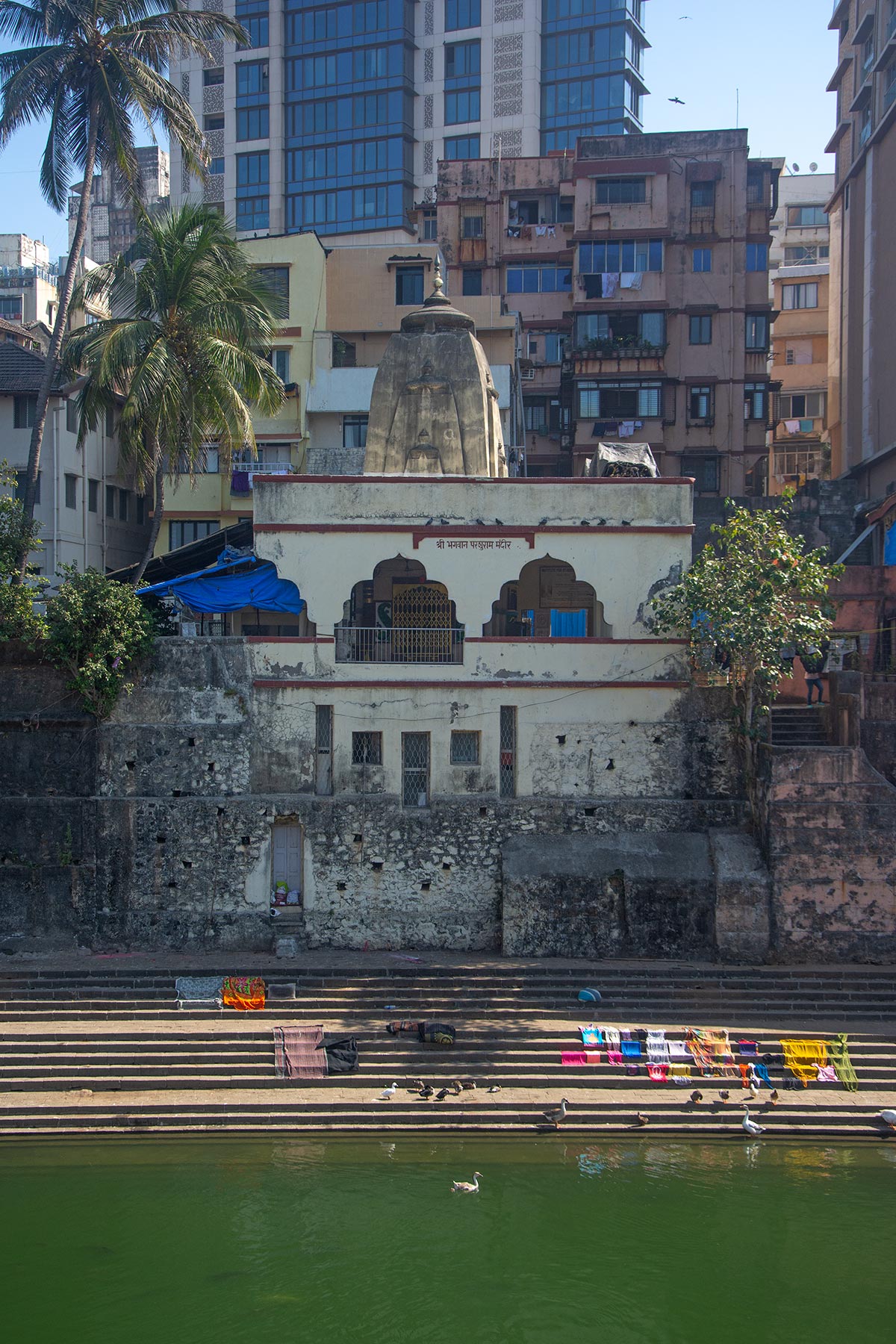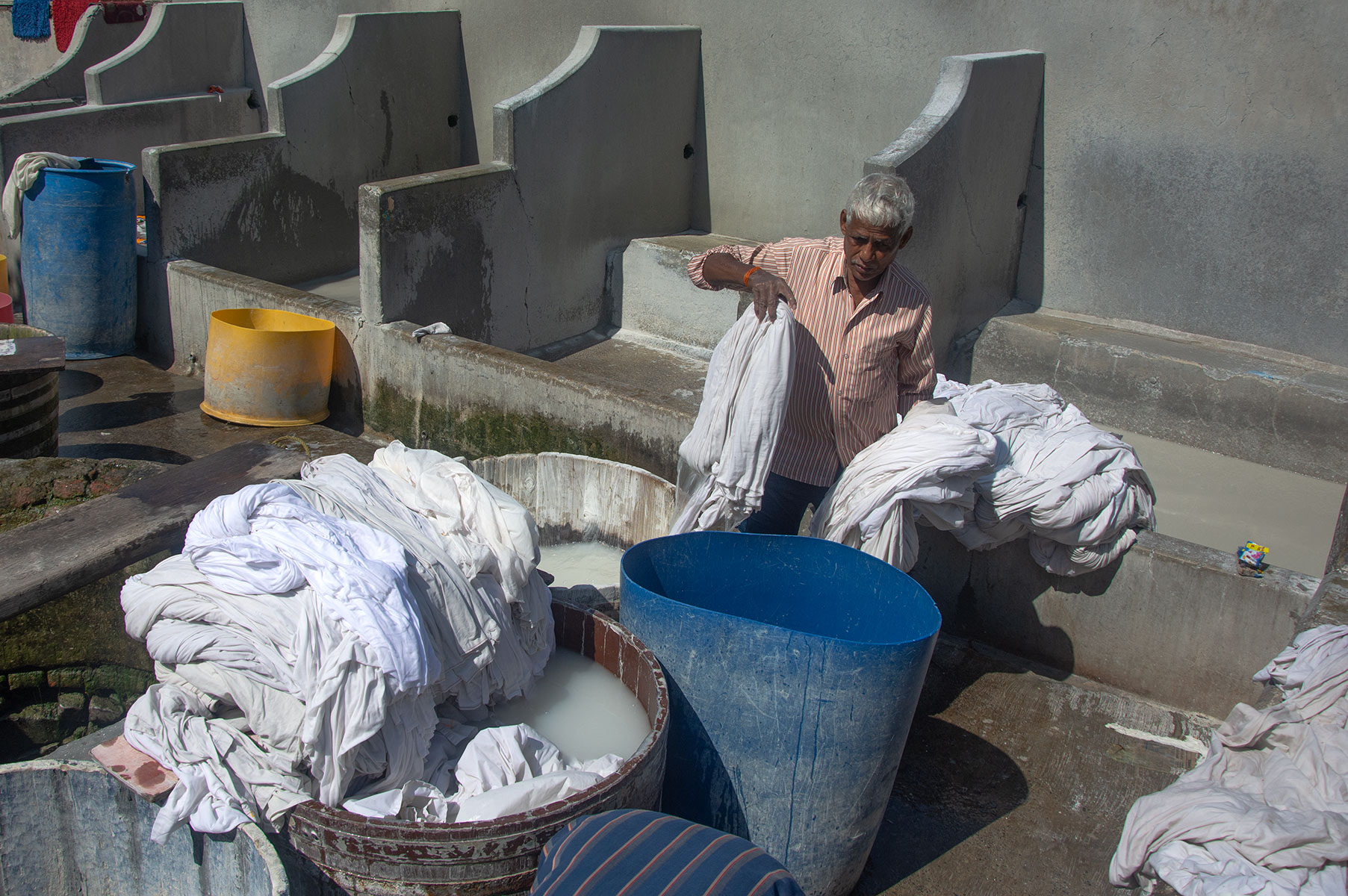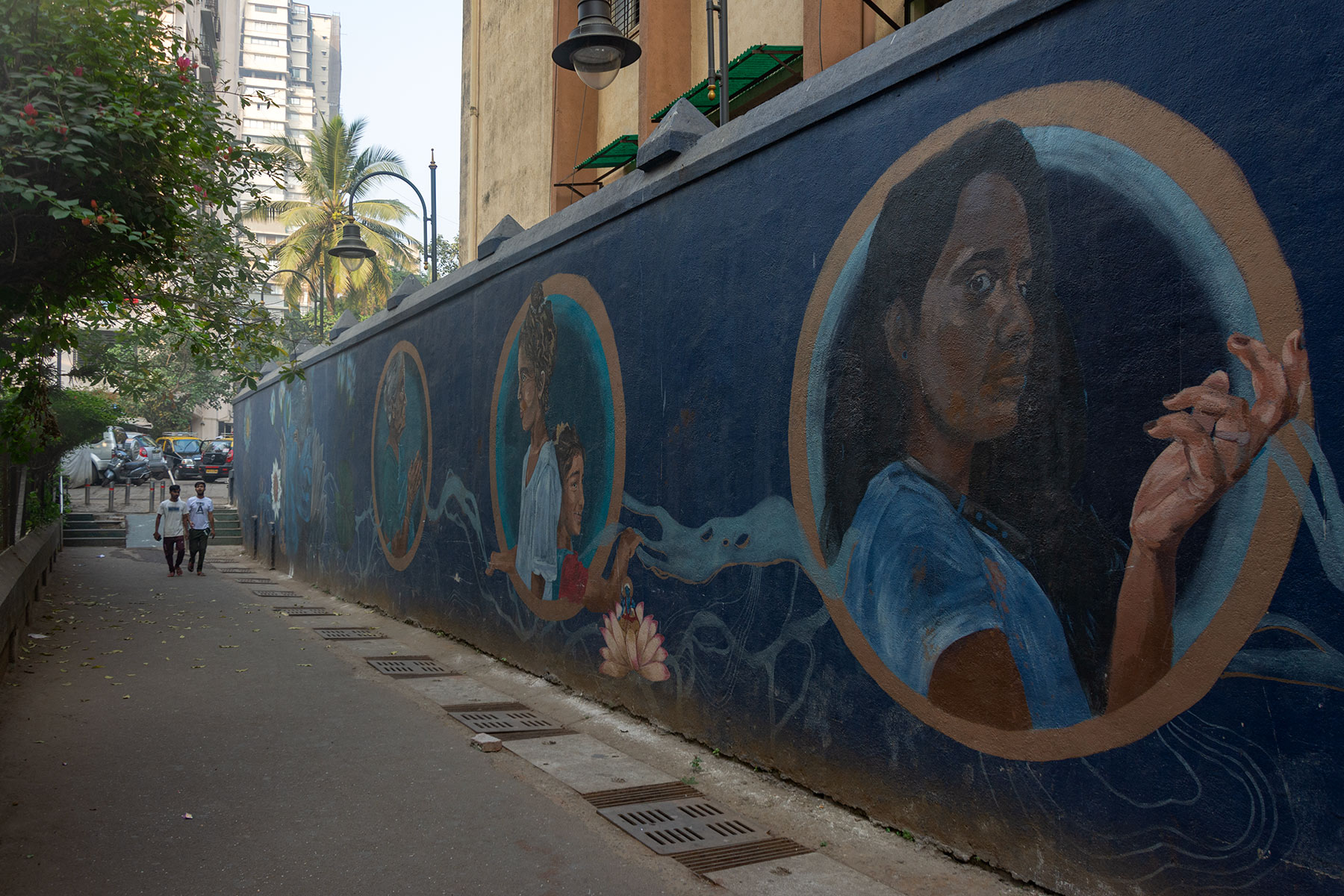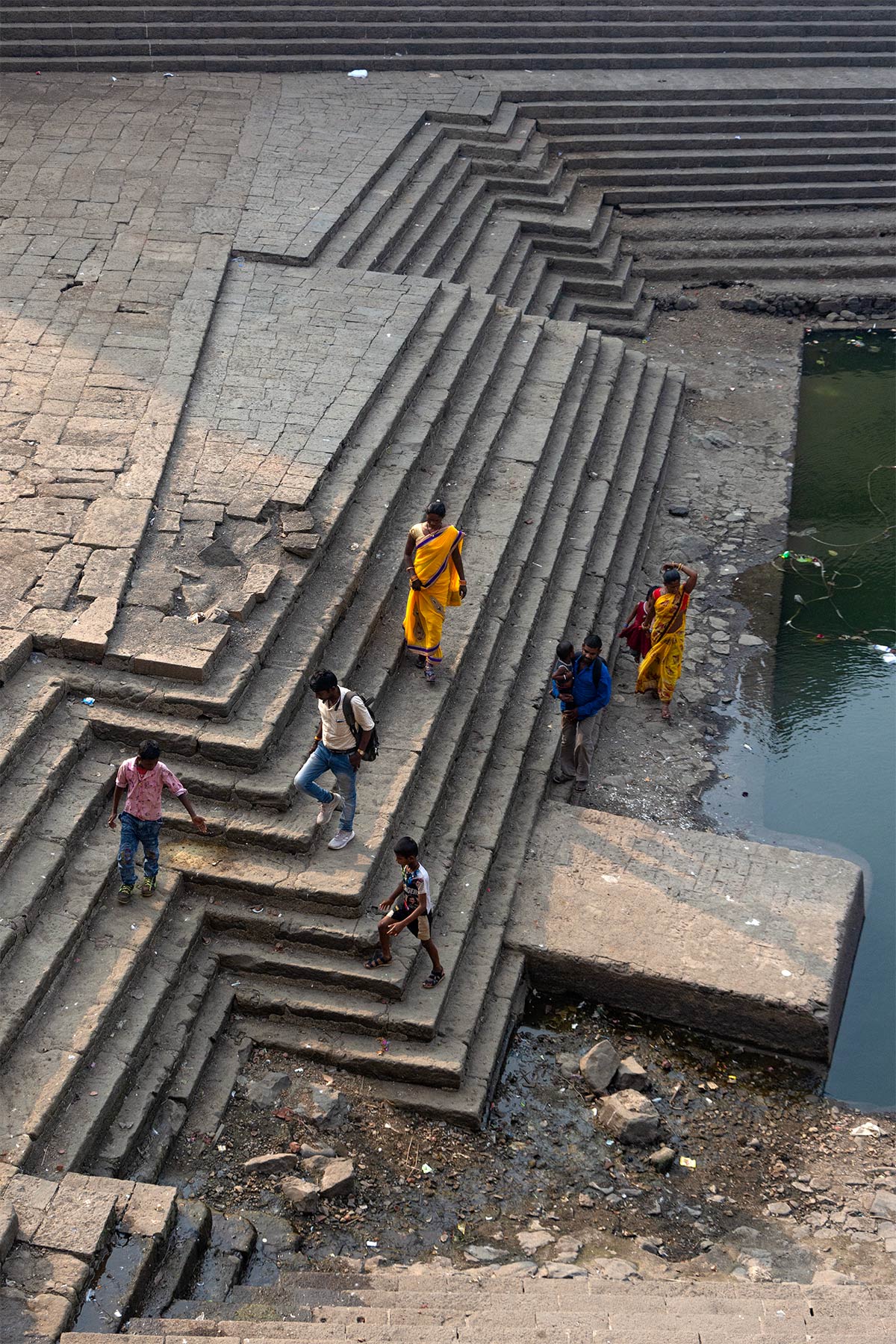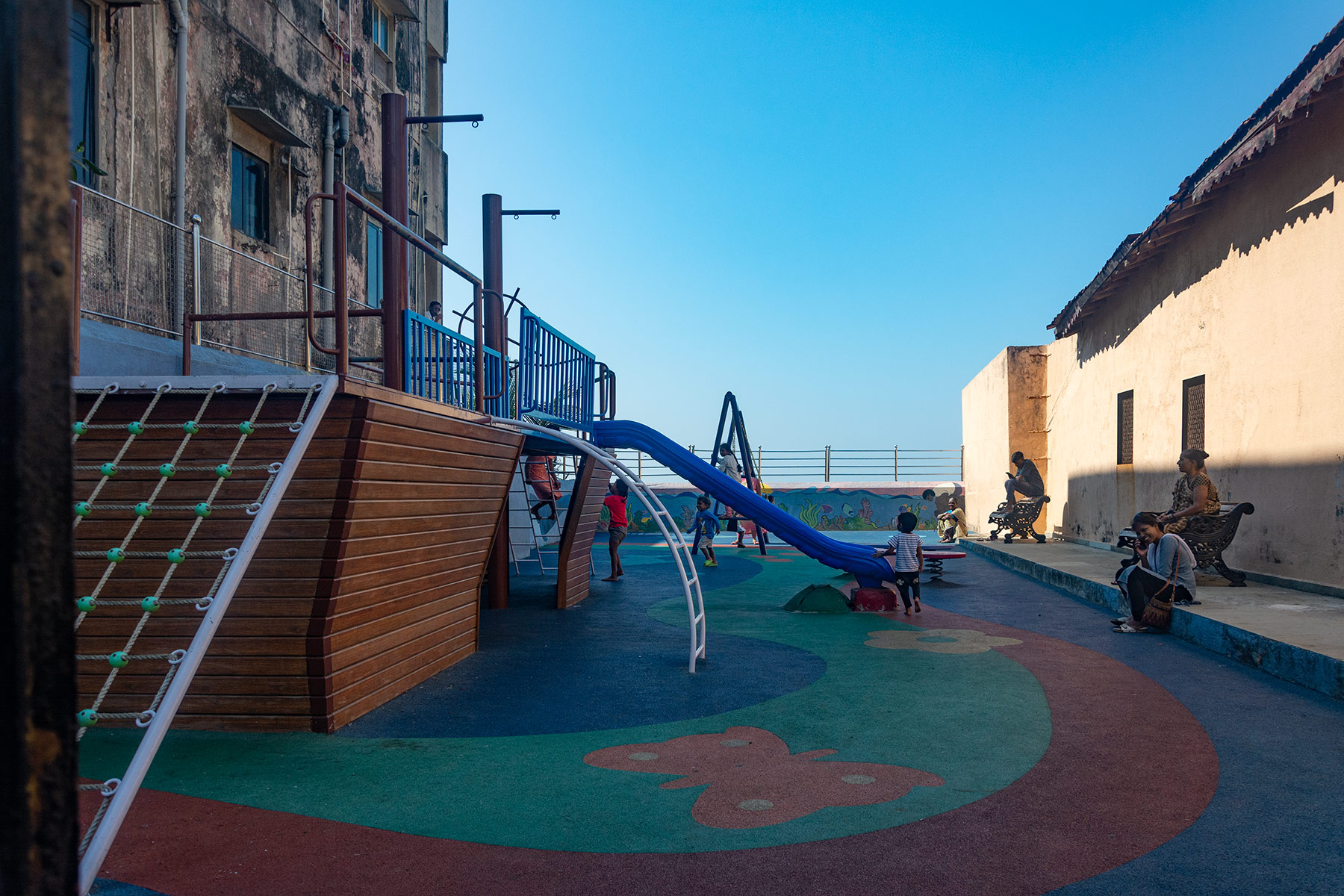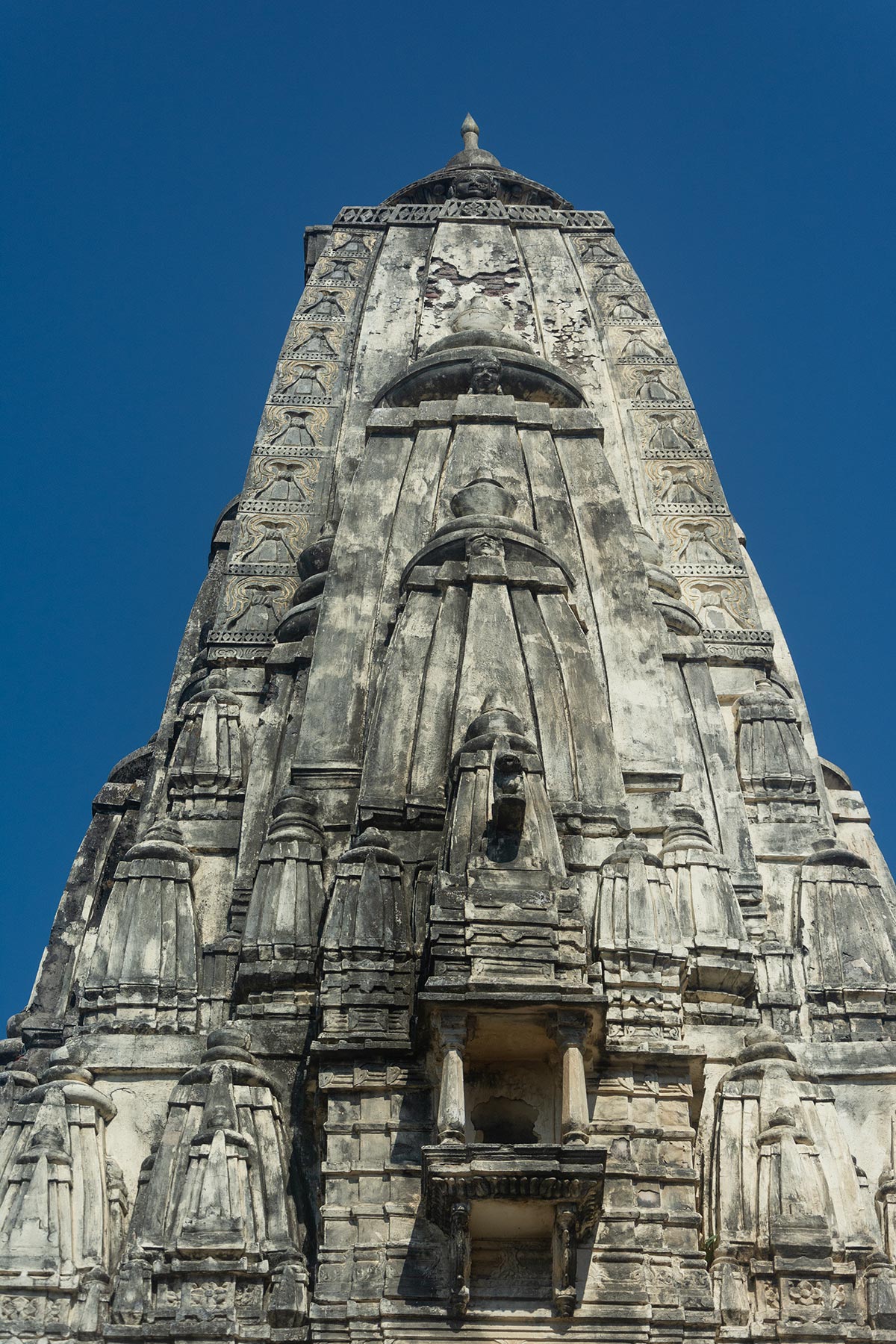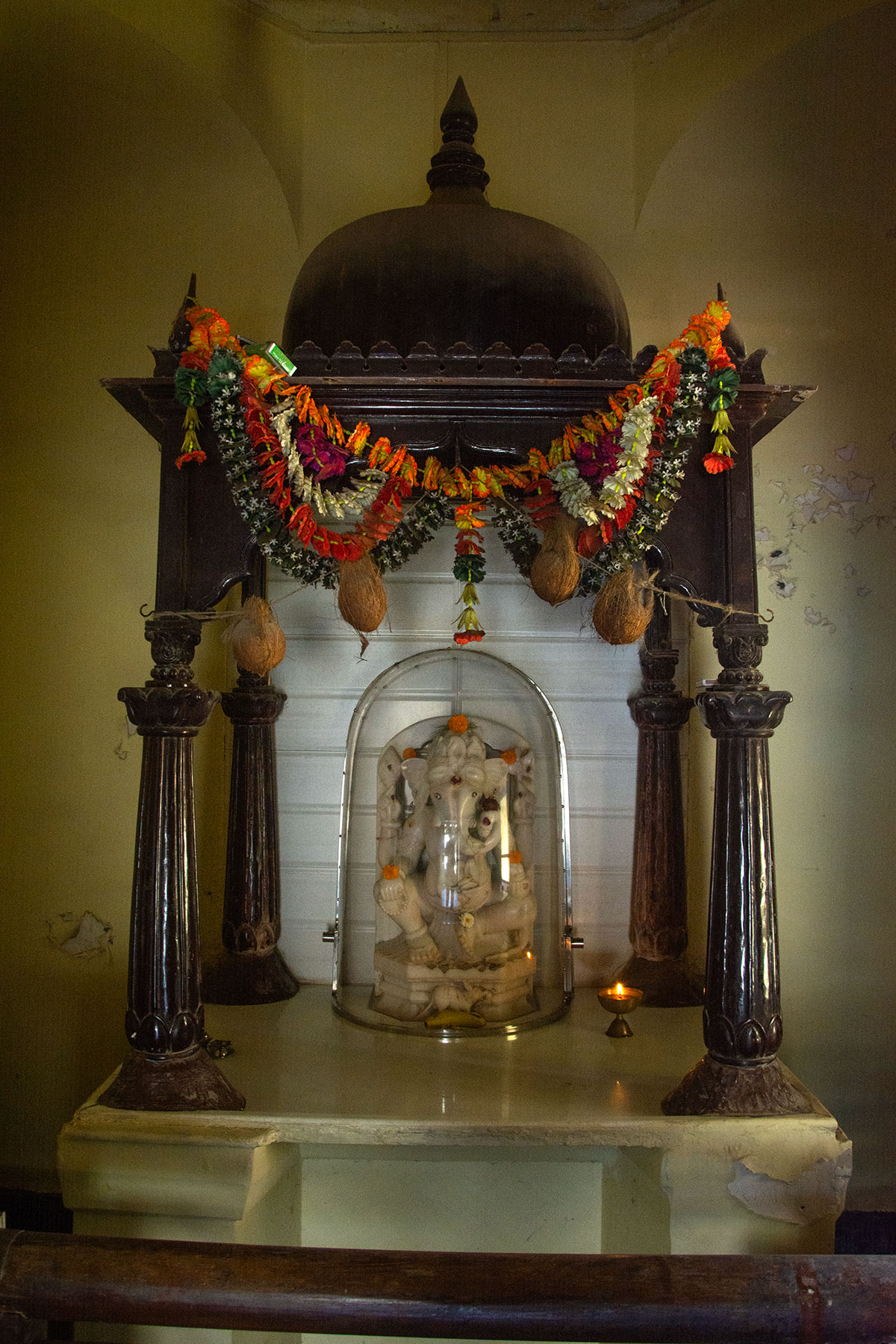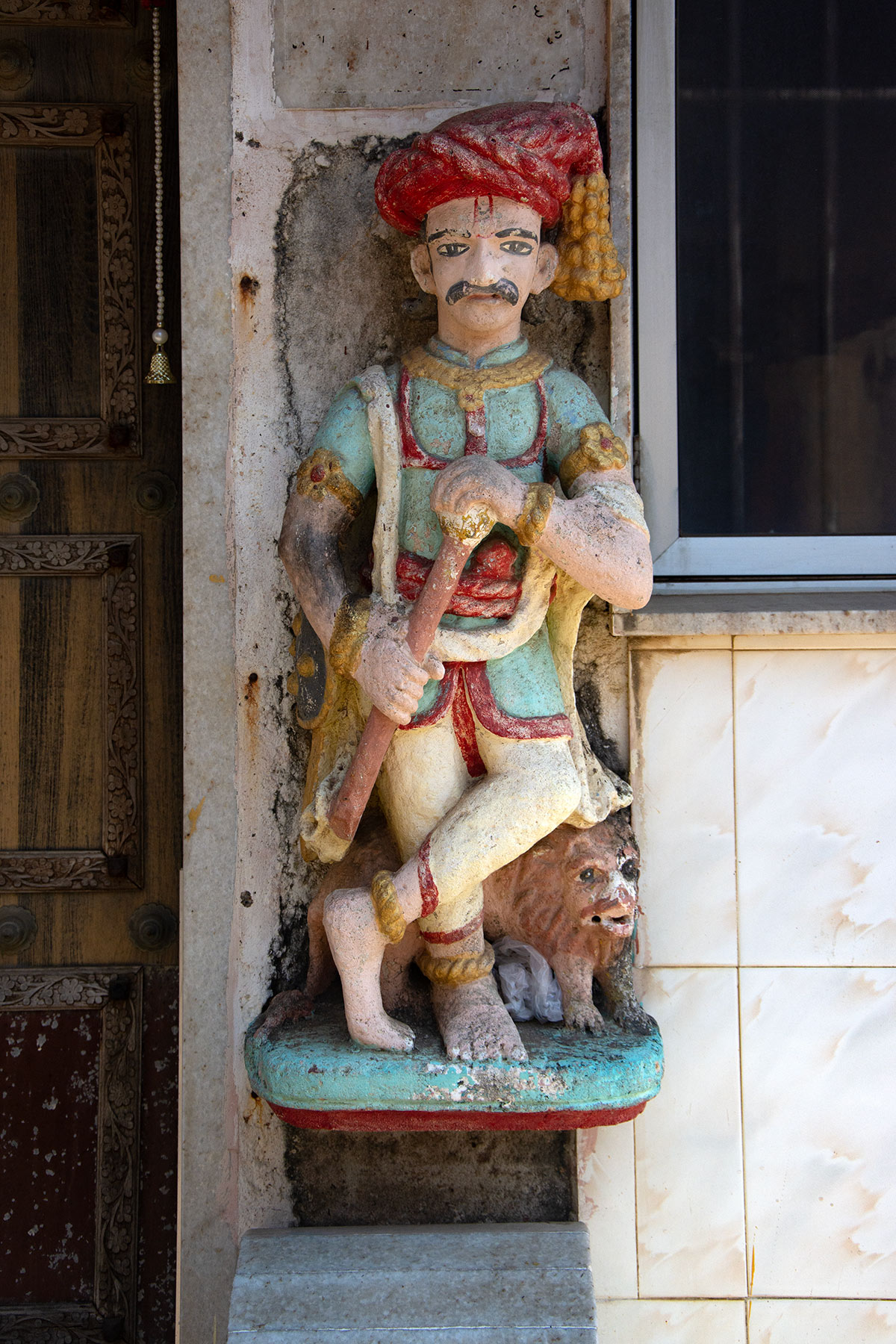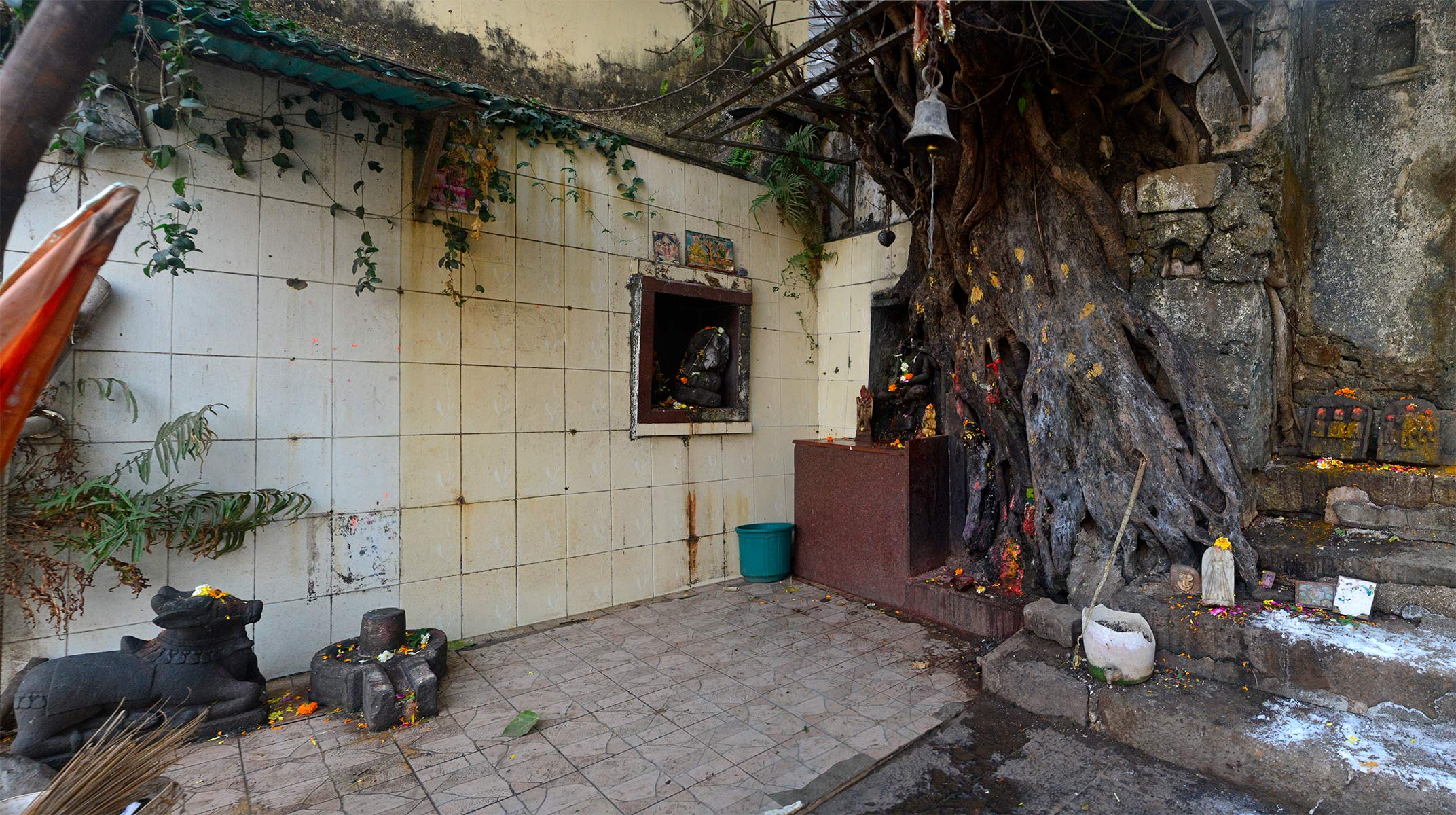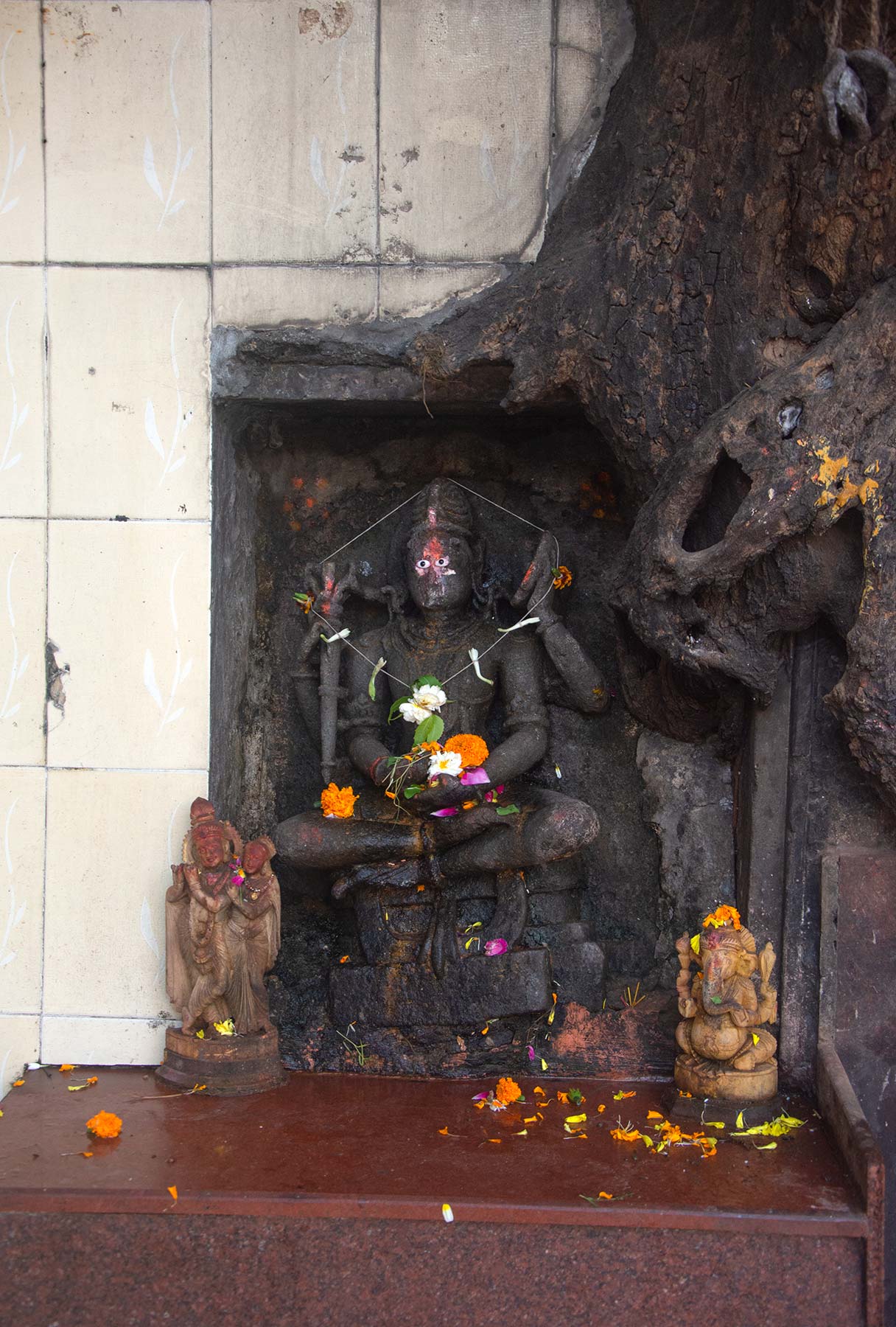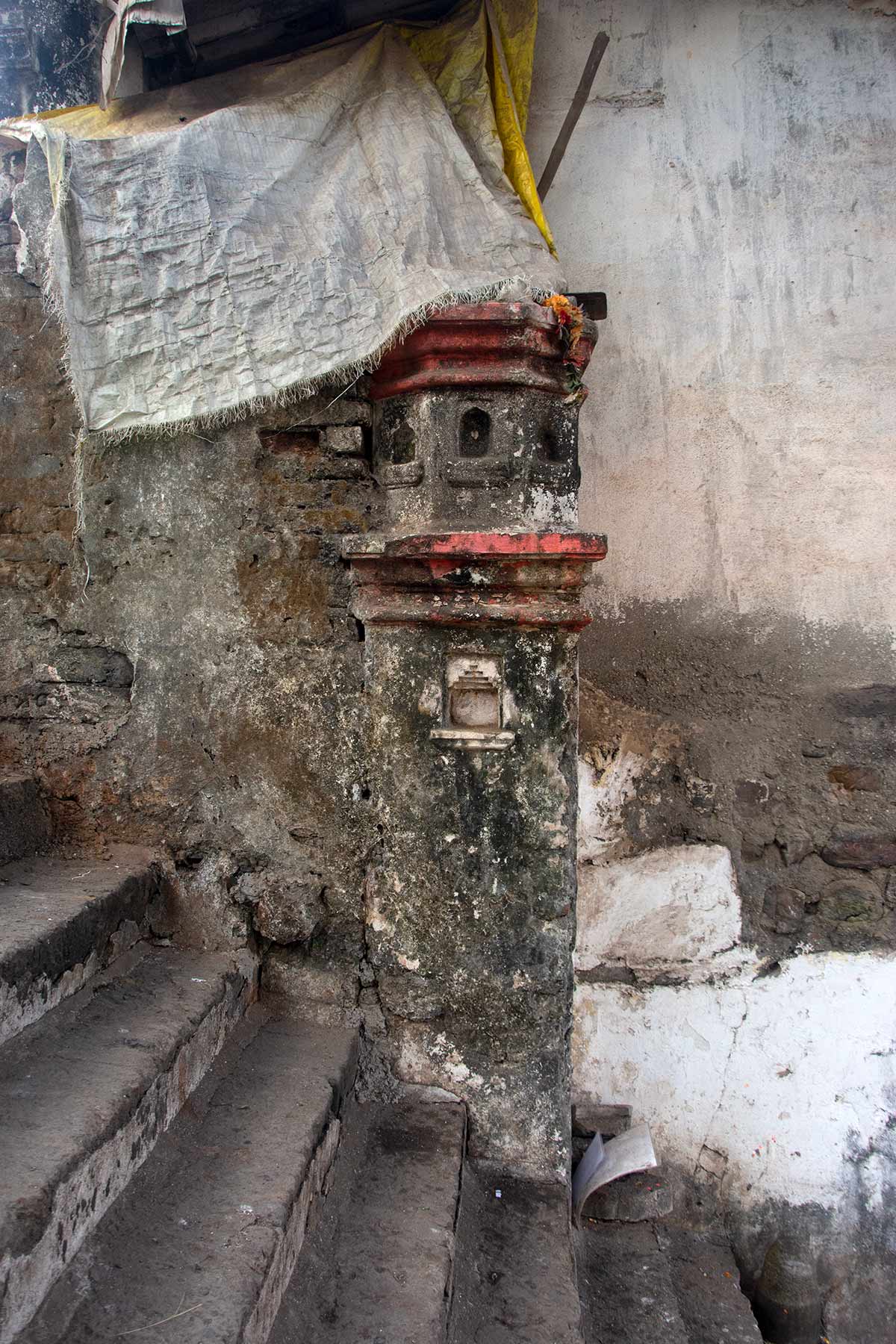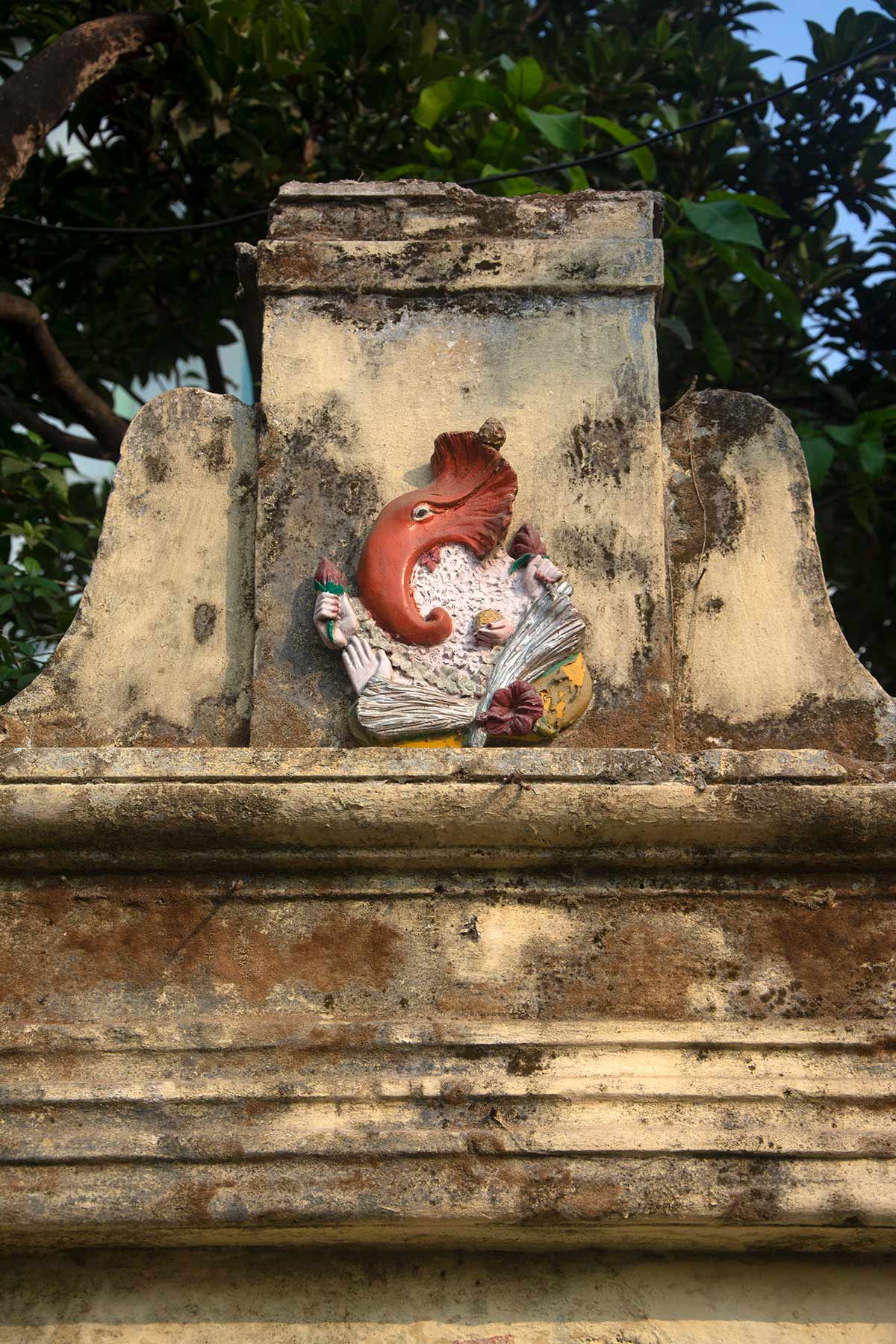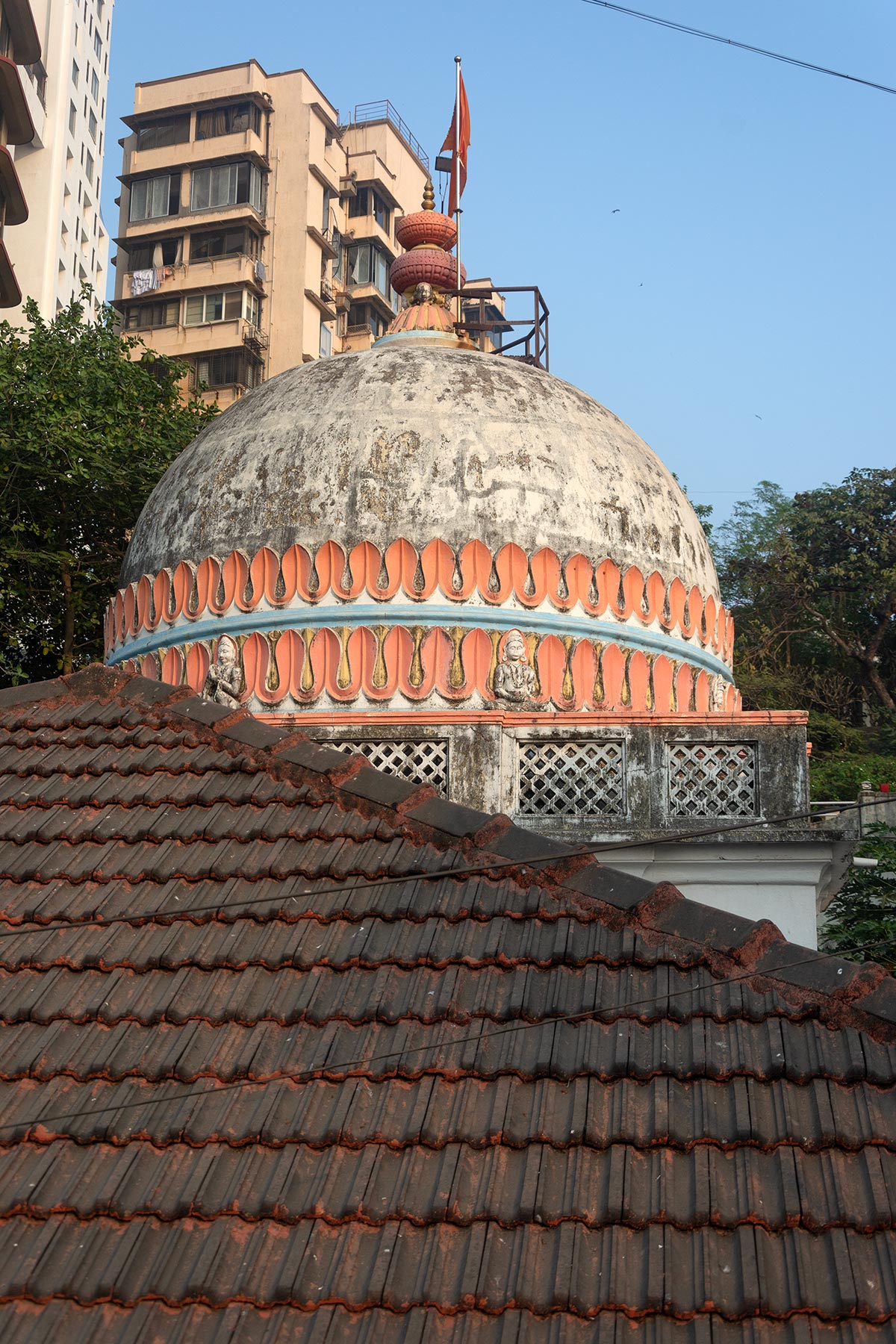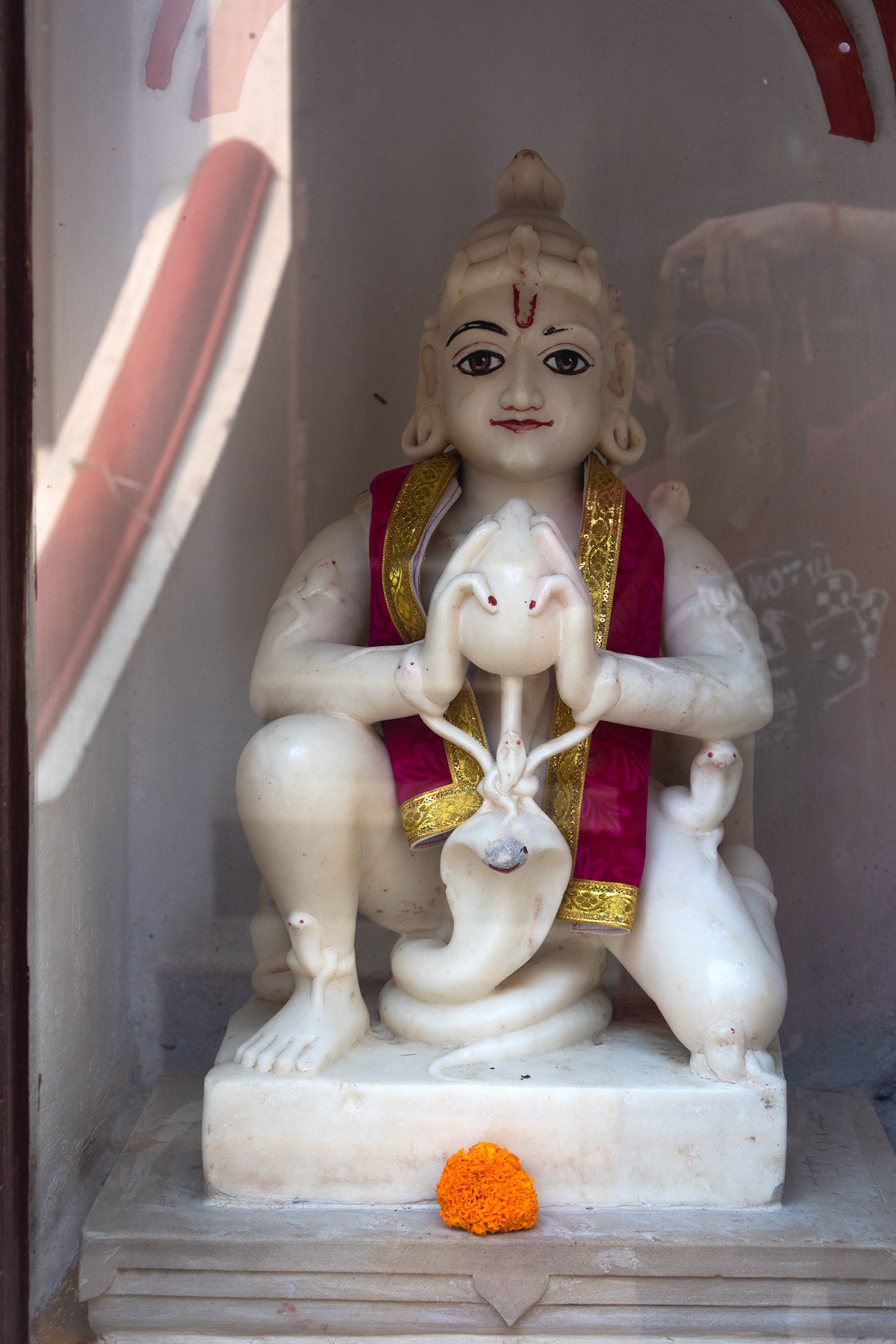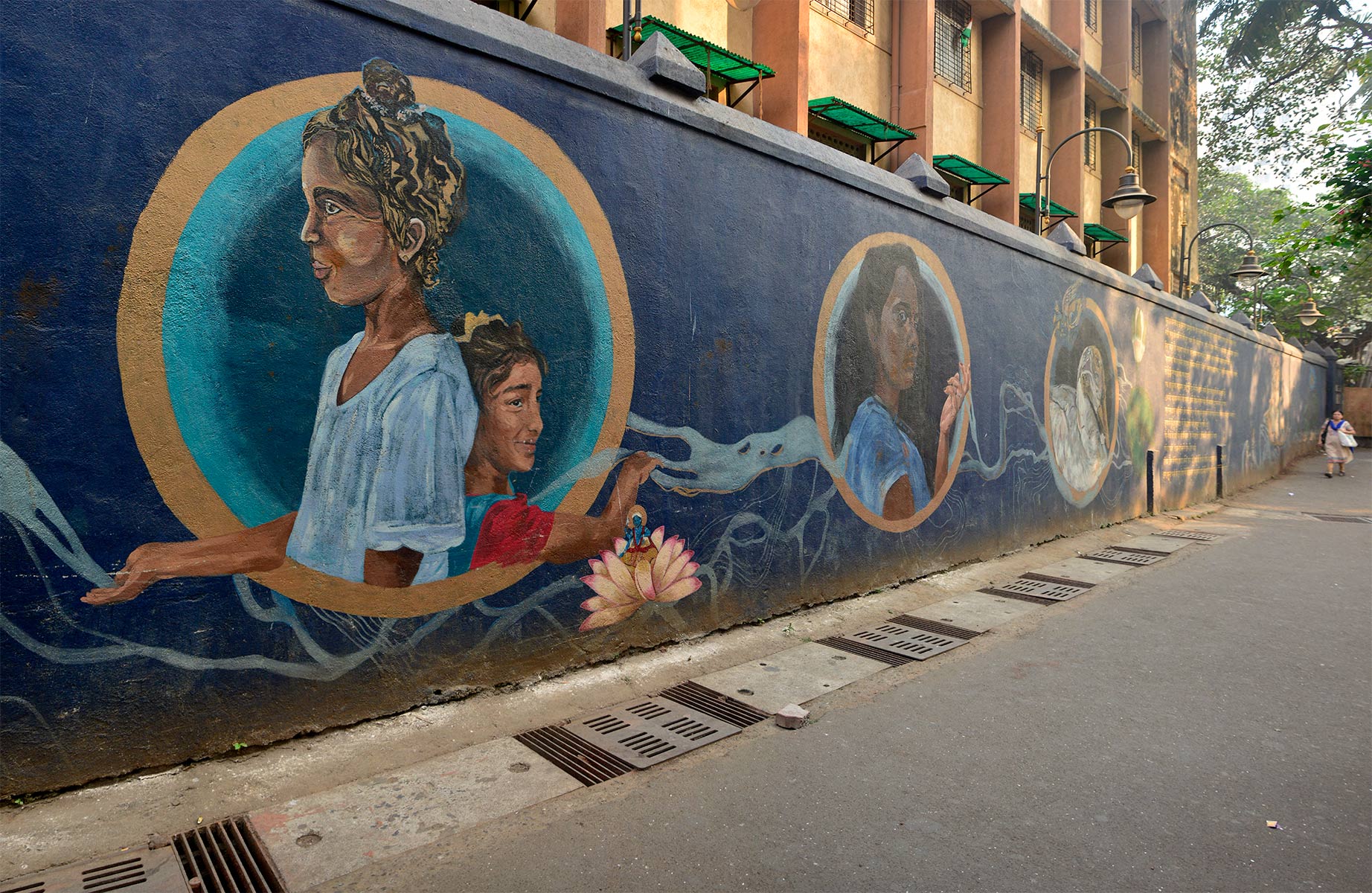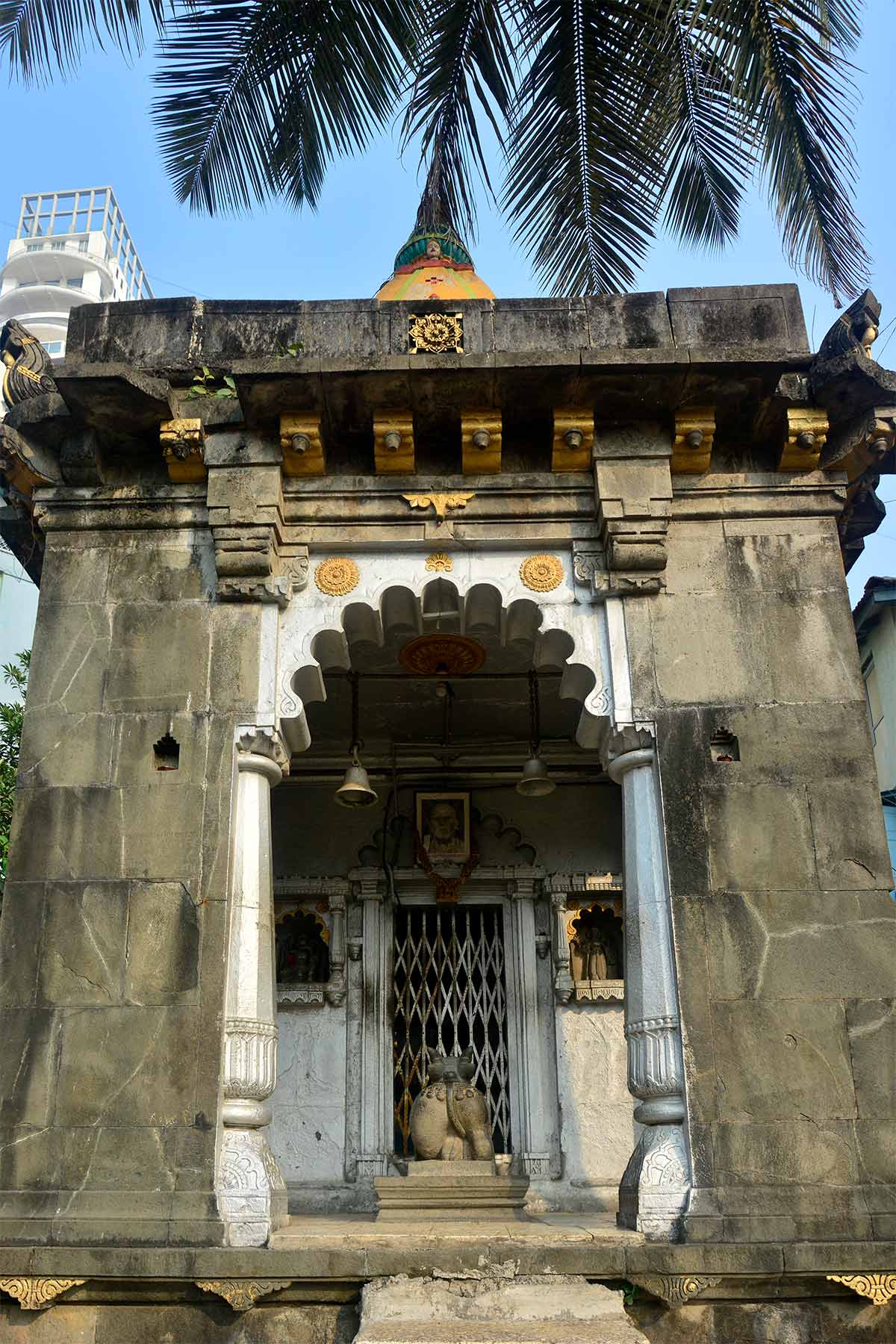Banganga Tank at Walkeshwar
Banganga Tank is located on the western fringes of Malabar Hill, close to Raj Bhawan. The neighbourhood around Banganga Tank is the oldest continuously inhabited region in Bombay, a site of great spiritual significance to Hindus. For centuries, Hindus have made a pilgrimage to the Walkeshwar Temple and the now-destroyed Shri Gundi stone at Malabar Point, which gave sanctity to the hill from a very early age.
The popular myth regarding how Walkeshwar got its name originates from the Ramayana. It is believed that Lord Ram and Lakshman visited the Banganga site during their search for Sita. Rishis met them and suggested that Rama install a potent lingam he brought from Varanasi. However, considering the duration of Lakshman's return journey, Rama fashioned a shivling from the sand. People named this lingam (and the temple that later housed it) Walkeshwar (Walu = sand, Ishwar = God), giving the place its current name.
View of the Banganga Tank from the Parashuram temple
Hindu pilgrims perform parikrama (circumambulation) in a circular direction along a path around Banganga Tank, starting from the south end. The important temples are located on the parikrama. The ghats have spatial division according to specific rituals; south and west are used for rituals of the dead, and north and east are used for auspicious rites.
Ramayana connection with Walkeshwar and Banganga
The popular myth regarding how Walkeshwar got its name originates from the Ramayana. It is believed that Lord Ram and Lakshman had visited the site of Banganga during their search for Sita. They were met by rishis who suggested Rama install a potent lingam brought from Varanasi. However, given the time it would take Lakshman to make the return journey, a shivling was made out of the sand. This lingam (and the temple that later housed it) was called Walkeshwar (Walu = sand, Ishwar = God), giving the place its current name.
Hinduism worships the River Ganges as a fertility goddess, the giver of life, and the protector of humanity. Artist Shilo Shiv Suleman painted this wall mural at Walkeshwar, personifying the river Ganges as the goddess Ganga. Hindu rituals use the water of Banganga Tank for purification, immersing ashes in it, believing it to be as pure as the Ganges, the holiest of all rivers.
Entrance to the Shree Jagannath Mahadev temple
The Jagannath Mahadev Temple has one of the two naubatkhanas at Walkeshwar, the other being at Vyankatesh Balaji Temple. The current occupants of the temple, many of whom live as tenants, have built the naubatkhana over the arched gateway for residential purposes. A carved wooden door, which leads to the inner courtyard, opens the arched gateway to the street.
Towering skyscrapers built on Malabar Hill overlooking Banganga Tank
Towering skyscrapers on Malabar Hill overlook Banganga Tank. In the 18th century, the hill was densely forested and visited only by Hindu pilgrims and Malabari pirates. Later, in the 1880s, the British Governor shifted Raj Bhawan from Parel to Malabar Hill, and the neighborhood has since become one of Mumbai's most sought-after real estates.
Banganga tank on Malabar Hill in Mumbai
Banganga Tank, located on Malabar Hill, is the oldest and largest surviving Hindu place of pilgrimage in Mumbai. It is still in its historical location. The tank has been a tirthasthan (place of pilgrimage) at least since the 12th century, and stories of its origin even earlier are mentioned in the Skanda Purana. It is believed Lord Rama visited the site during his search for Sita.
Rites and rituals performed at the Ghats of Banganga Tank
Early European visitors to Walkeshwar refer to the site as a 'Brahmin village'. The ghats surrounding Banganga Tank are maintained by the Gaud Saraswat Brahmin Temple Trust. The materials required for performing ceremonies, like flowers, incense, and coconut, are arranged by hereditary Brahmin priests from diverse communities living at Walkeshwar for many centuries. They perform a variety of Hindu rituals, such as thread ceremonies, childbirth, marriages, cremation rites, morning and evening libations, and offerings of pitripujas and shraddh.
A natural spring located at the northeast corner of Banganga Tank
A natural spring at the northeast corner feeds Banganga Tank. It is believed that this was the point where Lord Rama shot an arrow (bana) into the ground, thereby releasing the waters of the underground Ganges (Patalganga), hence the name Banganga. The water that emerges from the spring is considered pure and used in Hindu rituals.
View of the Banganga Tank from the Parashuram temple
Hindu pilgrims perform parikrama (circumambulation) in a circular direction along a path around Banganga Tank, starting from the south end. The important temples are located on the parikrama. Specific rituals divide the ghats spatially; rituals of the dead take place in the south and west, while auspicious rites take place in the north and east.
Paved stone steps going down from Walkeshwar Temple to Banganga Tank
There are stone steps that descend from Walkeshwar Temple to Banganga Tank. Historically, the ghats connected most temples along the parikrama, enabling pilgrims to directly enter the temple after performing purification rituals in the tank. Unfortunately, encroachments on the ghats have blocked access to the tank at several points.
A dhwajastambh (flagpole) stands in the middle of the Banganga Tank
In the middle of Banganga Tank stands a dhwajastambh (flagpole), which symbolises Mount Meru, considered by Hindus to be the centre of the physical, metaphysical, and spiritual universes. The water symbolises the cosmic ocean, used in Hindu rituals performed on the ghats, the water symbolizes the cosmic ocean. The nearby crematorium also uses the tank for the immersion of ashes.
Ghats on the northern end of Banganga Tank
Underground valves control the water level in the Banganga Tank, and overflow outlets empty into the nearby Arabian Sea. During the monsoon months, the tank can overflow unless regulated by the outlet valves. When the water level is low, it reveals the natural spring from which water enters the tank, which otherwise remains submerged.
Variety of fishes fed by pilgrims in Banganga Tank
The Banganga Tank caters not only to the spiritual needs of humans but is also a source of drinking water for birds and neighbourhood animals, particularly during the hot summer months. Pilgrims feed a variety of fish in the tank's waters daily as an act of piety and jeeva kalyan (animal welfare).
Ghats serve multiple purposes, both religious and secular, and are a hub of activity during Hindu festivals like Shivratri, Ganesh Chaturthi, and Diwali. Pilgrims use the Banganga tank to bathe, perform suryanamaskar at dawn, and immerse idols. The Banganga tank served as the primary source of drinking water before homes began to provide piped water.
Temples at the northeast corner of Banganga Tank
Temples at the northeast corner of Banganga Tank: (from left to right) Mahalakshmi Temple (yellow wall), Vyankatesh Balaji Temple (white dome), Jagannath Mahadeo Temple (white shikara), and Siddheshwar Temple (yellow shikhara). Over time, new buildings and encroachments have blocked the view of the temples from the ghats.
Winged celestial dancer on pillar capital at Jabreshwar temple
Built in the North Indian Nagara style, the Jabreshwar Mahadev Temple features an elegant shikhara that rises above the garbagriha. Carvings of musicians, lions, monkeys, and elephants adorn the shikhara. The Sabha Mandap's exterior wall features an arched makara torana flanked by celestial dancers on pillar capitals. The local Koli style of saree drapes these winged female figures.
Deepstambhas (lamp pillars) are a distinguishing feature of Hindu temple architecture in Maharashtra and Goa. Previously, people used the deepstambhas at Walkeshwar for illumination during Deepavali and other significant Hindu festivals, such as Dussehra and Shivratri. A person would climb the deepstambhas and place diyas on the extended branches or in small niches. Over time, Walkeshwar has discontinued this practice, and now the deepstambhas serve as a resting place for pigeons.
Jabreshwar Mahadev Temple seen from Jabreshwar Gali
Banganga Tank and Walkeshwar are located at the foot of Malabar Hill's western face, on the Arabian Sea's breaking point. The stone-paved Jabreshwar Gali is one of two alleys leading to Banganga Tank from Walkeshwar Road, which runs along the ridge of Malabar Hill. The eponymous Jabreshwar Temple is the most prominent temple in Jabreshwar Gali. It was built in the 1840s by Nathuram Ramdas, the father of a leading Bombay merchant, Sir Mangaldas Nathubhai.
The lingam inside the garbhagriha of Jabreshwar Mahadev temple
The Mangaldas Trust manages the Jabreshwar Mahadev Temple, while the priest family residing within the temple premises maintains it. The temple dedicates itself to Lord Shiva. The garbagriha worships a stone lingam alongside the goddess Parvati. The Sabha mandap houses the worship of Nandi and Hanuman. At Walkeshwar, we close all temples from 1 pm to 4 pm to clean the garbagriha and wash the deities.
View of the Rameshwar temple and the Ganapati temple
Raghoba Jivaji Jayakar constructed the Rameshwar Temple in 1842. He was a member of the Pathare Prabhu community. TIt is believed that an older Koli temple served as the foundation for the temple, which combines a Nagara-style pyramidal shikhara and a Konkan-style sabhagriha. n front of Rameshwar Temple overlooking Banganga Tank ghats is the domed Ganapati Temple, also built by Raghoba Jivaji Jayakar in 1842.
View of the southern group of deepsthambhs and dharamshalas
The southern end of Banganga Tank had many dharamshalas (rest houses) for pilgrims who stayed for long periods. These were not open to the general public but affiliated with certain castes, professions, or geographic regions. The current occupants have modified and converted the Dharamshala into residential spaces over time.
Southern group of deepsthambhs
The deepsthambhs at the southern end of Banganga Tank are not only the largest in terms of their size; they are also unique in design, having influences from Goan temples. Those in the southeast corner are carved with figures. Locals believe these deepstambhas, built over the samadhis (burial places) of revered saints, serve as markers.
Garbhagriha (left) and mandapa (right) of Jabreshwar temple
Squeezed on a flat plinth along the slope of Jabreshwar Gali, the black stone Jabreshwar Mahadev Temple stands. According to an urban legend, the temple's quirky name was apparently built on land acquired by force (jabardasti). The entrance to the temple opens to Jabreshwar Gali from the side because of buildings surrounding it on three sides.
Smaller shrines around Banganga Tank
Walkeshwar is filled with numerous temples, samadhis, and open shrines. Homes host kuldevta shrines, while wall niches and doorways display protective deities. The sacred peepal tree provides shade for the assembly of stone relics collected from the older Walkeshwar Temple.
Sabha mandap inside the Rameshwar Temple
The sabha mandapa inside Rameshwar Temple has retained the wooden ceiling and timber pillars. In 1934, a local merchant, Lallubhai Tribhuvandas, gifted the marble floor in memory of his wife. The Indian Heritage Society Mumbai renovated the Rameshwar Temple in 2005, using funds donated by the Narotam Sekhsaria Foundation.
Entrance of the Lakshmi Narayan temple
Mathuradas Damodardas Jhaveri built the Lakshmi Narayan temple in the 1890s as a memorial to his late wife, Kesarbai. The Jhaveris are jewellers, and they historically migrated to Mumbai from Gujarat; hence, elements of Gujarati architecture are reflected in the sitting platform (otla), the use of Gujarati language, and the use of decorative torana over the door.
Relics from the original Walkeshwar Temple
The heavily eroded panel sits on the steps leading down to Banganga Tank. The Shilahara rulers built the old Walkeshwar Temple, which is believed to have included these stone panels. The Portuguese demolished the temple. Many of the broken pieces now litter the tank. The British brought some of the better-preserved carvings to England, where they are currently on display at the India House Museum in South Kensington.
Vermillion-coated memorial stones
The north end of Banganga Tank has a collection of stone relics. They commonly depict a horse and rider, its features hidden under a thick layer of vermillion smeared by worshippers. It is unknown what the stones represent or where they were sourced from, but it is likely they are memorials erected for warriors who died in battle.
Lingam inside the Garbagriha at Walkeshwar Temple
The lingam worshipped in Walkeshwar Temple's garbagriha is said to be swayambhu (self-manifested). The lingam has a brass kavach (armour) and is protected within the coil of a brass Naga (serpent). It is believed that this lingam was brought from Varanasi by Lakshman; hence, Walkeshwar is also referred to as Lakshmaneswar.
The Onkareshwar Mahadeo Temple, commissioned by Mathuradas Dwarkadas. This temple is flanked by a squat deepstambha. The temple is dedicated to Lord Shiva, represented by a stone lingam that is fabled to be swayambhu (self-manifesting). Next to the temple stands an old banyan tree.
Torana (entrance) at the Mahalaxmi Temple
The Mahalaxmi Temple, known for its framed torana (marble arch), is the newest temple in the Banganga Tank precinct. The shrine at the base of a peepal tree in the northeast corner of the tank served as the foundation for its construction. Members of the Shrimali Brahmin community from Rajasthan built it in 1973. In 2021, they refurbished the temple.
Built in 1781, during the period of Peshwa rule in the Deccan, the Vyankatesh Balaji Temple is a typical Peshwa-style temple, with its arched nagarkhana gateway, Mangalore tiled roofing, and a high domed roof. The pujaris family, who maintain the temple, still occupy the courtyard and dharamshala inside. The site's asymmetric layout places the gateway off-centre.
Naubatkhana and deepsthambh at the Vyankatesh Balaji Temple
The Vyankatesh Balaji Temple incorporates diverse architectural elements within a compact forecourt. The entrance gate doubles as a naubatkhana (drum house); a flight of steps leads to a platform where musicians played the nagara and shehnai. Next to the gateway are shrines dedicated to Garuda and Ganesha, separated by a deepastambha.
Sabhamandapa at the Vyankatesh Balaji Temple
The sabha mandap at Vyankatesh Balaji temple has sophisticated woodwork and a Pradakshina corridor around the garbagriha. The use of timber columns and arched panels reflects architecture from the Peshwa period. A devotee named Diveshankar constructed the present temple in 1781 on the site of an older Koli temple.
Garbagriha at the Vyankatesh Balaji Temple
Entrance to the garbagriha at Vyankatesh Balaji Temple. The doorway has niches on either side. On the left is Lord Hanuman, wearing a crown, armed with a bow and arrow, and praying with folded hands. On the right is Lord Ganesha, who is also wearing a crown. Both idols, as well as the garbagriha of Lord Balaji, are made of marble quarried in Rajasthan.
Lakshmidas Jagjivandas, a Bombay merchant, founded the Jagannath Mahadev Temple around 1858. The temple is known for its mix of past and present elements, such as the use of asbestos shade over the sabha mandap, intricately carved wooden brackets, and bathroom tiles in the garbagriha replicating Raja Ravi Varma's artwork. A Nagara-style shikhara mounts the stone lingam in the inner sanctum.
Nandi shrine at Jagannath Mahadev Temple
Jagannath Mahadev Temple features a turtle in front of Nandi, both facing the garbagriha. This arrangement is seen at all Shiva temples in Walkeshwar, according to various theories. It is believed that a turtle can retract within its shell, symbolising withdrawal from the material world (moh-maya) and entering a state of samadhi (meditative consciousness).
An ascetic named Ramdas Bawa originally built Rama Mandir. Bhawanai Mohanji, a Khatri merchant, reconstructed Rama Mandir in 1918 and added a shikara over the garbagriha. The garbagriha enshrines marble idols of Lord Ram, Lakshman, and Sita from the original temple. The Pujari family, which maintains the temple, lives at the rear.
A lady named Hariganga Ranchhoddas Bhansali once owned a garden at Parashuram Temple. In February 1965, Hariganga Ranchhoddas Bhansali donated the land, paving the way for the construction of the Parashuram Temple, which now stands overlooking the western steps of Banganga Tank. Parashuram is an avatar of Lord Vishnu. The Skanda Purana mentions how Parashuram threw his parashu (battle axe) into the sea to reclaim the narrow strip of land along the Konkan coast, starting from Maharashtra all the way to Kerala, which is also known as Parashuram-kshetra.
The local Dhobi Ghat is a little further away from Banganga Tank on Dr. Bhagwanlal Indrajit Marg. Dhobis wash their clothes manually, using water from a deep well. Dhobis dry their laundry in the sea breeze and hang it on cable lines without using clips, instead twining it between cables.
Bust of Shri Jagannath Shankarseth at Banganga cremation ground
Among the many contributions of philanthropist Jagannath Shankarseth was the donation of land to the north of Banganga Tank to be used as burning ground for those Hindus who wished to be cremated at Walkeshwar in the vicinity of the Banganga Tank. A bust of Jagannath Shankarseth is now installed at the crematorium which is also named after him.
Samadhis and memorials at Walkeshwar
The Banganga tank precincts brim with shrines and memorials honoring those who achieved samadhi, a state of meditative consciousness, and chose burial over cremation. The Dasmaniya Akhada burial ground has been in use since the 18th century as a cemetery for sanyasis of the Goswami community, who attained samadhi here.
Street art by Shilo Shiv Suleman on the theme of water
Award-winning installation artist Shilo Shiv Suleman created a contemporary wall mural in the northeast lane to Banganga Tank in 2021. Titled Pyaas, it draws attention to the origin myth of the Banganga Tank. The theme alludes to the role of women and the importance of water in the daily lives and livelihoods of the local residents at Walkeshwar.
Ghats at the southern end of Banganga Tank
Hindu pilgrims perform parikrama on a path around Banganga Tank, starting from the south end. The important temples are located on the parikrama path. Specific rituals divide the ghats spatially; rituals of the dead take place in the south and west, while auspicious rites take place in the north and east.
Marine theme playground for neighborhood kids
One of the latest additions to community spaces around the Banganga Tank is this marine-themed playground adjacent to Rameshwar Temple. This site was earlier used as a garbage dumping ground before it was revamped by the RPG Foundation as part of the Banganga Revival Project and is now a place of fun and games for the neighbourhood kids.
Shikara of the Rameshwar Temple
Towering above the Banganga Tank is the weathered shikara of Rameshwar Temple, built in the North Indian Nagara style with amalaka (a stone disc in temple architecture) and kalash (an architectural element shaped like a metal pot with a large base and a narrow mouth) at the summit. On the four sides of the shikara, small figures of lions appear, and on its east face, facing the tank, there is a carving of Lord Shiva as Nataraja.
Ganesh idol at Ganapati Temple
The Ganapati Temple worships this nine-inch-tall Ganesha idol. The glass casing encloses the white marble idol from Rajasthan. The shrine is constructed from wood and has a dome similar to the one on top of the temple.
Dwarapala at Lakshmi Narayan Temple
At the Lakshmi Narayan Temple, the mace-bearing dwarapala wears the Marathi turban, known as pheta or pataka. Vishnu temples model their dwarapalas after Jaya and Vijaya, the gatekeepers of Vaikuntha, Lord Vishnu's heavenly abode. The appearance of a small lion at the base is an intriguing detail.
A distinct material culture at Banganga Tank is the popularity of bathroom tiles for decor and restoration purposes. Temples not only use the tiles for floors, but also for walls and the interior of garbagrihas. This shrine under a banyan tree in front of Walkeshwar Temple has been restored with bathroom tiles.
Shiva idol beneath the Banyan tree
Banganga Tank has several legends associated with it, and they have diverse origins. As time has passed, memories of local incidents have become intertwined with these origin myths. One such prevailing story is how the original lingam at Walkeshwar Temple was lost to the sea in order to avoid desecration by mlecchas (referring to Muslim and Christian rule under the Gujarat Sultanate and the Portuguese). According to this belief, on Mahashivratri, the Koli fishing community ventured out to sea to offer prayers to the vanished lingam.
Over the years, there has been a lot of encroachment on and around the Banganga Tank, which has significantly altered the size, ambience, and historicity of the sites. The Urban Development Department of the Government of Maharashtra, through the Heritage Regulations for Greater Bombay 1995, declared the Banganga complex a heritage zone in April 1995 due to the activism of citizen groups concerned about the tank's deterioration.
Placement of lord Ganesha on the doorway
A common feature at all the temples and even private homes in Maharashtra is the presence of a Ganesha figure at the top of the entrance or doorway. People revere Lord Ganesha as the remover of obstacles and consider his presence as auspicious and a harbinger of good luck.
Domed roof of the Vyankatesh Balaji Temple
The Vyankatesh Balaji Temple has an amalgamation of various styles that were popular in the Deccan during the eighteenth century. For example, the domed roof, use of multi-foil arches, and double-layered foliated bands running around the dome's exterior are typical of Islamic architecture. On the other hand, elements from Hindu temples in the Konkan and Maharashtra regions include the Mangalore-tiled hip roof, wooden sabha mandap, musicians on the domed roof, and deepastambha.
Exterior view of the Vyankatesh Balaji Temple
The Vyankatesh Balaji Temple has retained many of its original architectural features, including the Mangalore tiled roof, thanks to the effort of conservation architect Sudhir Joshi. The interior receives natural light through high windows on three sides. The wooden balustrades on the windows signify the floor's use as a working space.
Garuda shrine at Vyankatesh Balaji Temple
The Vyankatesh Balaji Temple has a marble Garuda in a kneeling posture, offering fruit with both hands. However, this image is slightly different from the usual Garuda iconography, which is more ferocious. Usually, the depiction of Garuda features a pair of wings and a beaked bird-like nose, unlike this image. Nagas adorn the Garuda in this illustration. They coil around the arms, on the waist, and around the ankles. Instead of fighting Garuda, their mortal enemy, the Nagas appear to be paying homage to Lord Balaji in unison.
Wooden bracket at Jagannath Mahadev Temple
The Jagannath Mahadev Temple has anthropomorphic wood-carved brackets supporting the roof. These are female musicians playing a variety of musical instruments. They wear a blouse and skirt-like garment, heavily decorated with jewellery. Bright colours paint the brackets, adding a playful element to the temple's overall decor.
Wall mural done by Shilo Shiv Suleman
The Heritage Project draws attention to how women are integral to the growth and development of the Banganga neighborhood, as well as their role in sustaining ecology. Shilo Shiv Suleman depicts this interdependence using a mix of text, portraits, and elements of Hindu mythology to create awareness and promote dialogue for social change.
Formerly known as Jairamgir Bawa's Math, the Siddheshwar Mahadev temple houses the samadhis of ascetics from the orthodox Giri Smarta sect. Here, the founder (Jairamgir Bawa) and two other ascetics also built their samadhis. The temple overlooks the Banganga Tank and is notable for its arched gateway, greyish-blue basalt walls, pyramidical shikhara, and compact sabha mandap.
Dwarapala at the Vyankatesh Balaji Temple
At the entrance to Vyankatesh Balaji Temple, Dwarapala is holding a mace. Because of the temple's asymmetric layout and lack of wall space at the entrance, only a lone dwarapala stands guard instead of the usual pair.


